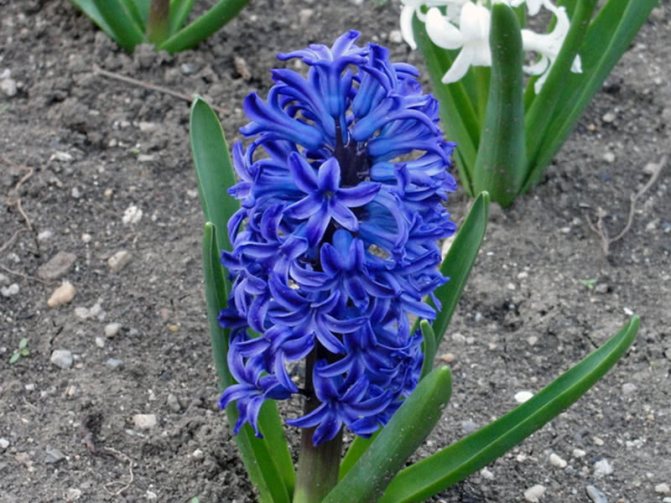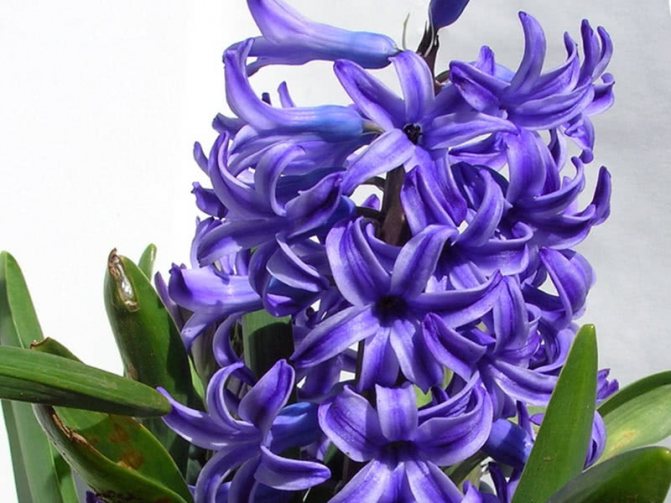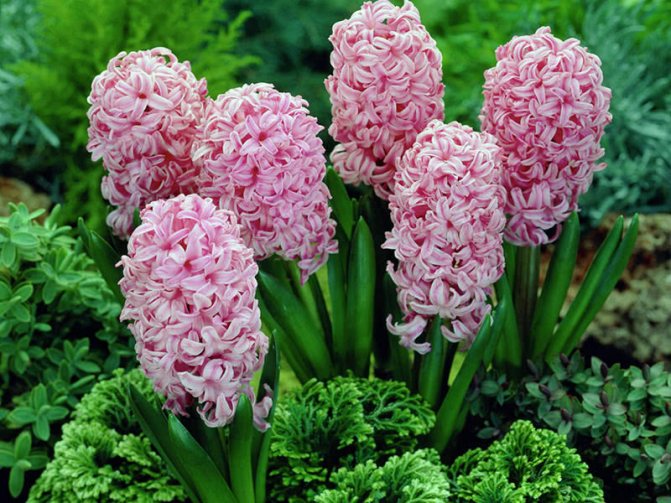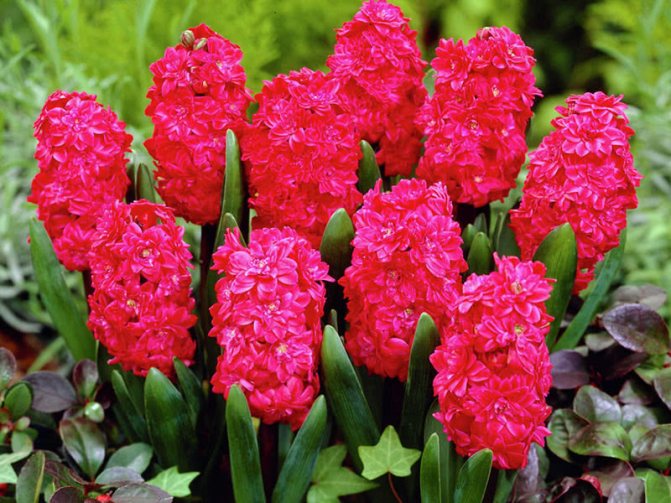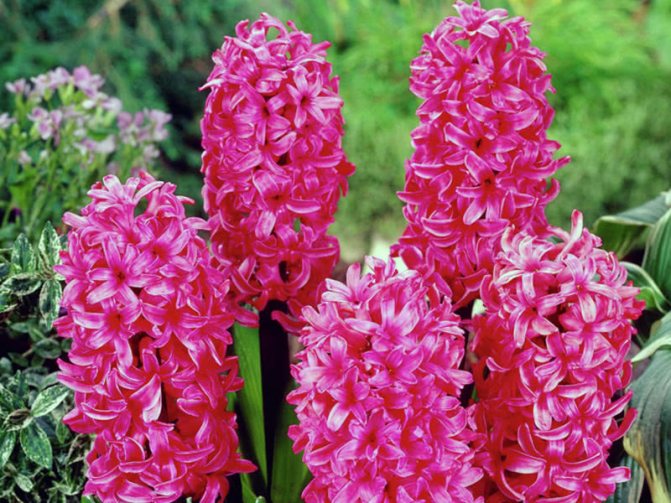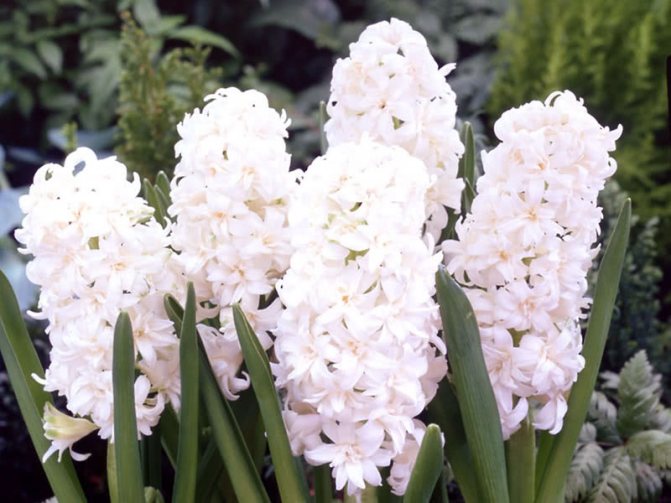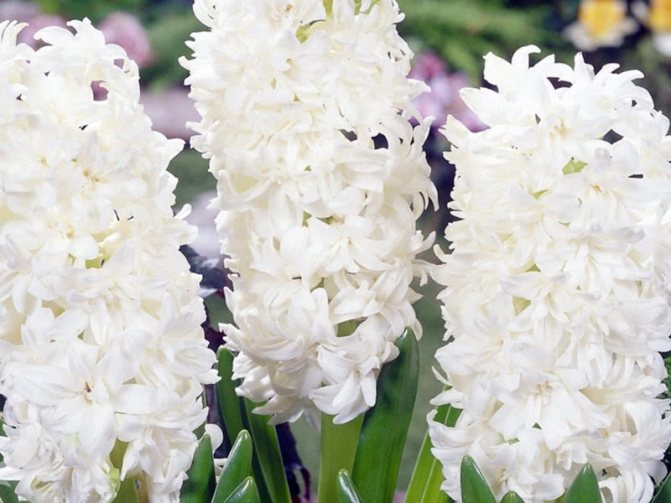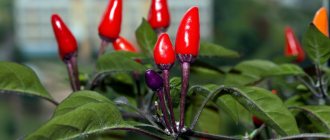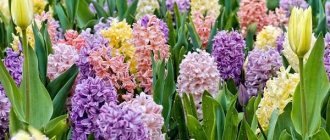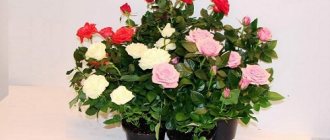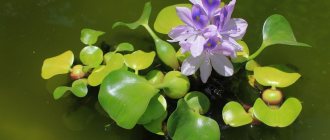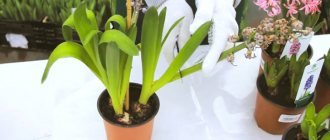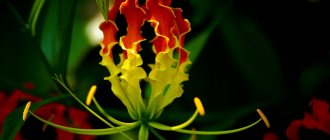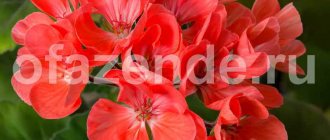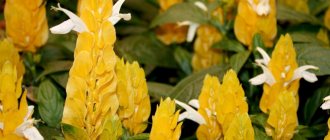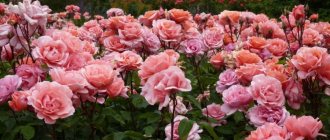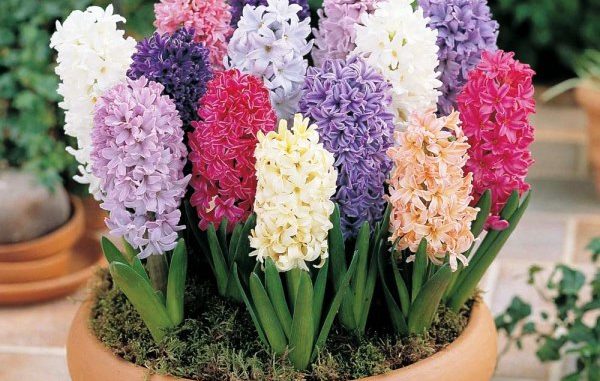
Hyacinth is a flower, the name of which is translated from Latin as a rain flower. It has such a name due to its love for excessive moisture, there is still an assumption that it is called so because of the flowering time of this plant in nature, namely in the spring during the rainy season.
Homeland of Hyacinth is Southeast Asia... In most cases, this bulbous flower is grown in gardens, but you can do it at home, however, caring for the plant in this case is slightly different.
Types of hyacinth
The genus Giacint unites only 3 species:
- hyacinth Oriental;
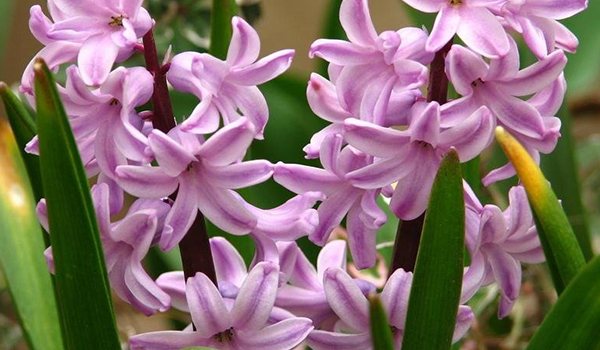

- hyacinth Litvinova;
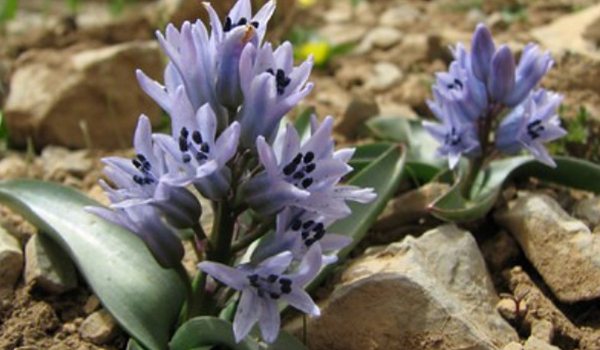

- hyacinth Transcaspian.
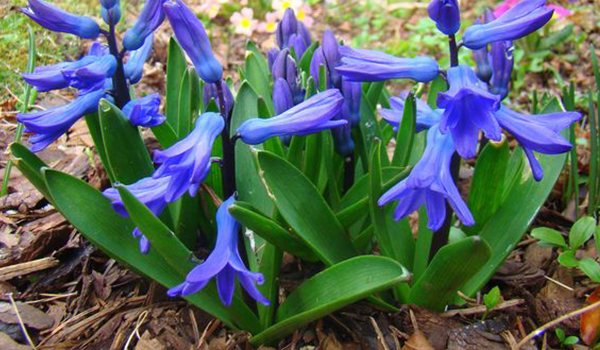

In decorative floriculture, only hyacinth orientalcharacterized by:
- dense fleshy bulb, the color of the upper layer of the scales of which correlates in the basic tone with a touch of petals;
- rosette leaves linear or elongated-oval shape with a pointed tip;
- erect peduncle, rising to a height of 30 cm and carrying out racemose aromatic inflorescence of flowers with dense bell-shaped corollas.
Description of the plant
Hyacinth is a perennial bulbous herb of the Asparagus family. The plant consists of a dense flat-round bulb, the scales of which in the upper part turn into narrow leaves. From its center, a flower stem grows with an inflorescence in the form of a brush with small fragrant flowers of various shades from snow-white to bluish-black. After flowering, fruits are formed in the form of a capsule containing seeds.
In nature, hyacinth reproduces both generatively - by seeds, and vegetatively, with the help of children that appear around the circumference of the bottom of the bulb. Under natural conditions, hyacinths grow in the countries of Southern Europe and Asia Minor. Several centuries ago, its fragrant inflorescences of bright and delicate colors were noticed by European breeders.
Important! Varieties with white and light flowers smell most intensely.
To date, more than five hundred varieties of hyacinths have been bred. The homeland of most of them is Holland, whose mild climate and light moist soils are the best suited for the cultivation of this fastidious "rain flower". For successful cultivation, you just need to recreate its usual conditions and take into account the natural cycle, when the dormant period precedes the flowering time.
Varieties popular for indoor cultivation
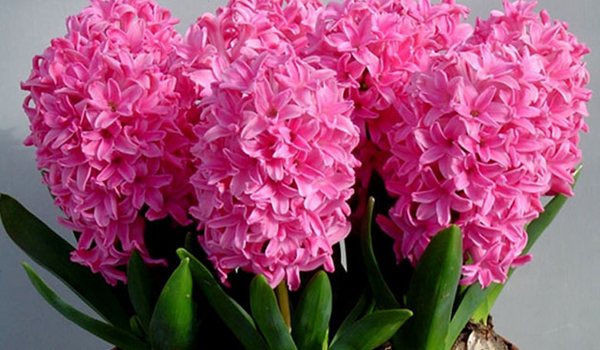

On the basis of Eastern hyacinth, the breeding method was used to obtain numerous hybrids, the description of which is different:
- the structure of the corollas: simple and terry;
- color of petals: white, yellow, orange, blue and purple, pink, red and black;
- flowering time: early, medium and late flowering.
Oriental hyacinth hybrids are extremely decorative, it is their numerous photos that the Internet is full of. Most fit for indoor cultivation... More often than others, there are varieties at home:
- Ostara, with high (up to 30 cm) peduncles and loose purple inflorescences about 13 cm longkeeping freshness for 3 weeks.
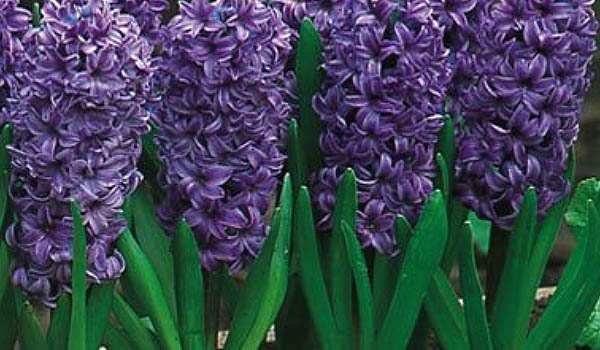

- Rosaliadiffering pink shades of inflorescencesconsisting of 15-17 small (2 cm in diameter) buds with a short flowering period.
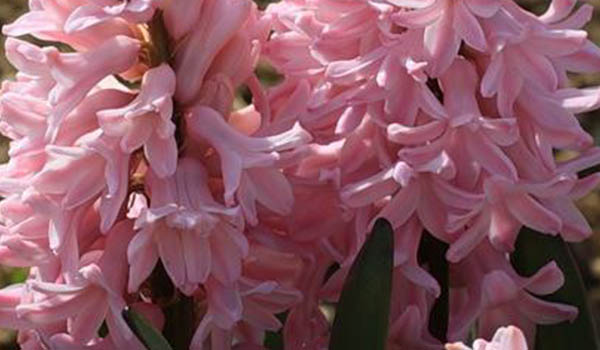

- Sunflower, with peduncles up to 20 cm high and creamy inflorescences of medium density, formed by small (3.5 cm) double flowers. Blooms 2 weeks.
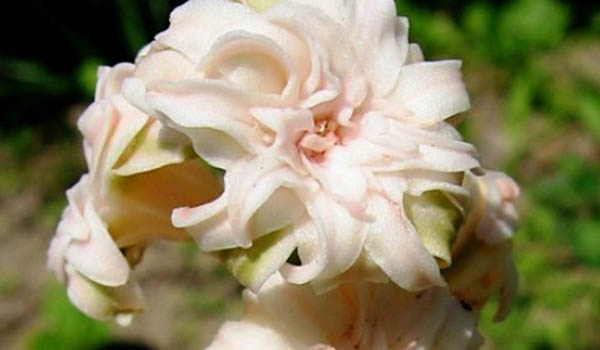

- Amethystcharacterized by a light purple color dense inflorescences up to 10 cm long and a weekly flowering period.
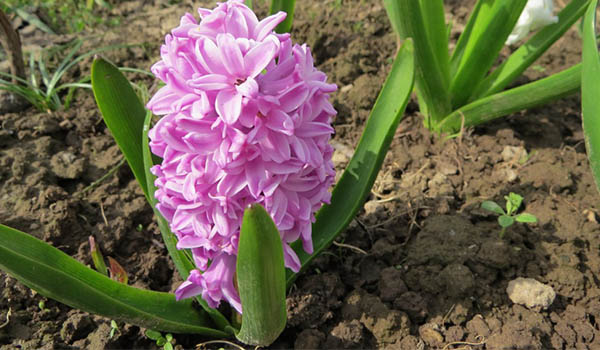

- La Victoire, which have gained popularity due to the dense inflorescences of spectacular bright red tones.
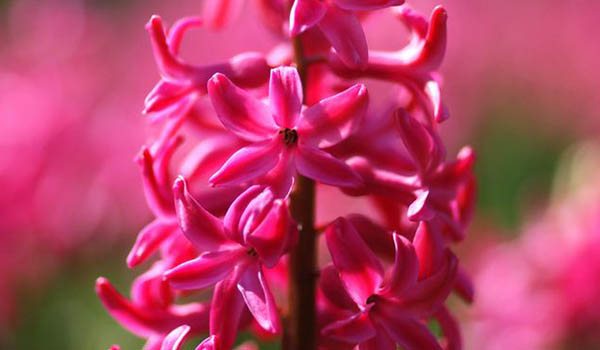

Types and varieties of homemade hyacinth
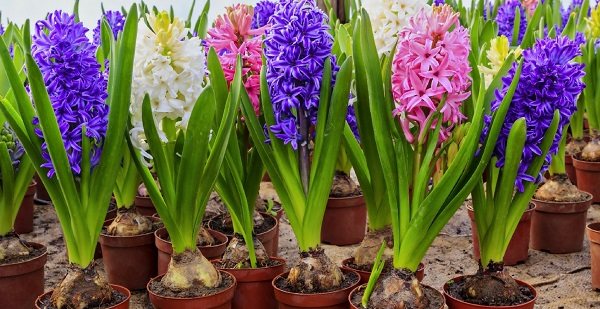

In nature, there are many varieties of luxurious bulbous plants, but only one is suitable for cultivation in an apartment and forcing bulbs. Oriental hyacinth is a species on the basis of which many hybrid varieties with buds of various colors have been bred.
Every year breeders give flower lovers new varieties with fantastic shades of petals.
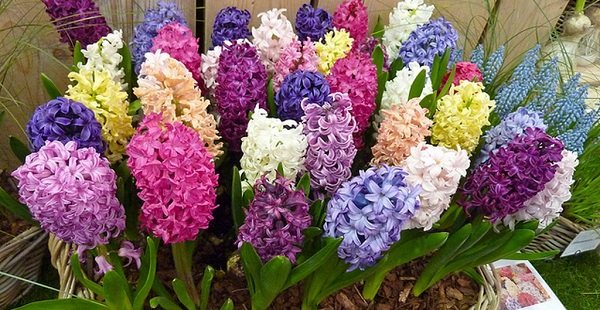

Popular tones:
- cream,
- snow white,
- Orange,
- deep yellow,
- lilac,
- dark violet,
- bright blue,
- blue,
- scarlet.
It's hard to forget what Hyacinth looks like. The photos show what delicate and bright colors are pleasing to the eye in winter cold and early spring.
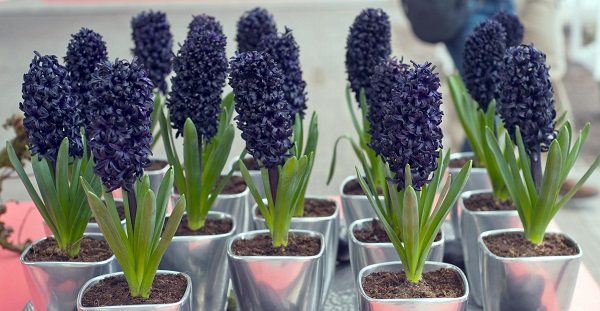

Popular varieties:
- Innosanm.
- Amethyst.
- Ostara.
- City of Harlem.
- Orange Bowen.
- Yillow Hammer.
- Delft Blue.
- Lord Balfour.
- Pink Pearl.
- Gypsy Queen.
- Anna Marie.
- Carnegie.
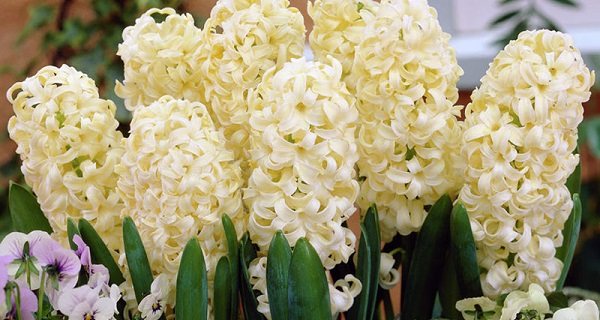

On a note:
- A perennial bulbous plant is tall and short, with one or several peduncles, and the shape of the buds is also different.
- The leaves are dark green, rather dense, directed upwards.
- From the center of the root rosette (leaf funnel), a peduncle of different lengths (depending on the variety) is pulled out, on which small flowers (up to 35 pieces or more) are tightly "planted".
- Further, the buds open, similar to a bell, but the petals are more bent from the center.
- A riot of colors pleases the eye for about a month.
- Regardless of the variety, Hyacinth has a delicious scent.
Varieties with different shades are revealed at different times: first - blue, then - pink, white, lilac, red. The varieties with yellow and orange petals bloom later than all.
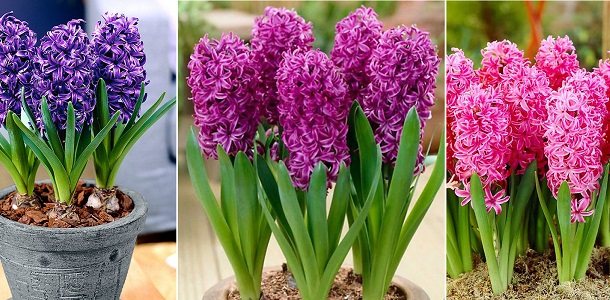

Home care
In order to understand whether it is possible and how to grow hyacinth in an apartment, it is necessary to get acquainted with the peculiarities of flower development.
The life cycle of a hyacinth consists of 2 phases:
- a period of active growth, falling in the spring and accompanied by the growth of leaves and flowering;
- a dormant period that occurs after flowering and lasts during the fall and winter. At that time the ground part of the plant dies off, the flower exists at the level of the bulb.
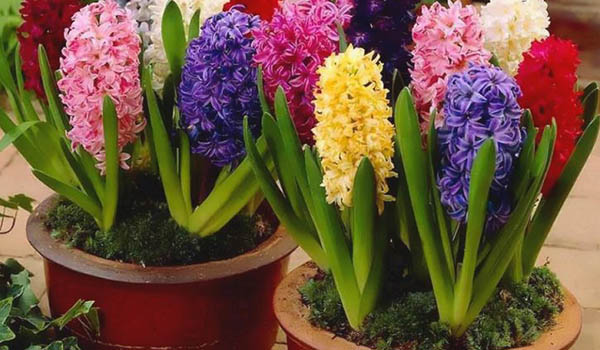

In each of the periods, hyacinth needs in creating certain conditions and competent care.
Location and lighting
Hyacinth is a light-loving plant... For a successful growing season, he needs a day of light lasting at least 15 hours, so it is better to place the flower at home on windows in the south or south-east direction.
On a sunny summer afternoon, the plant is darkened, in cloudy weather, as well as in early spring, it is additionally highlighted using phyto or fluorescent lamps.
During rest, the plant does not need light.
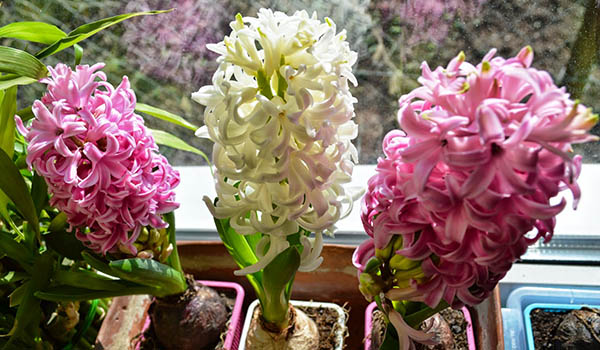

Temperature
One of the main conditions for the optimal development and high-quality flowering of hyacinth is compliance with the temperature regime:
- during the active growing season, the flower needs moderate warmth - 20, maximum 23 ° C;
- good rest, accompanied by the laying of flower buds, is possible only in the cool - 15-17 heat.
Attention! Hyacinth is sensitive to sharp temperature fluctuations, it does not tolerate proximity to heating devices and the presence of drafts.
Watering and humidity
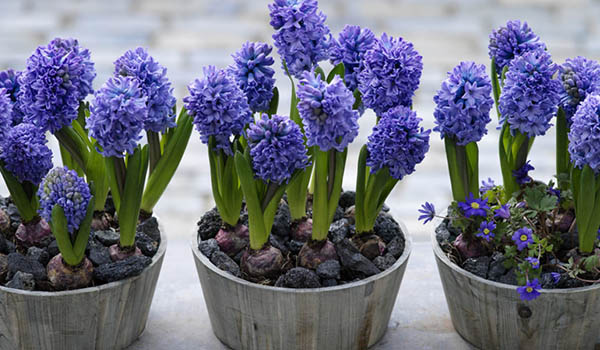

Hyacinth is very fond of water, therefore the soil in his pot should be slightly damp.
Under indoor conditions, the plant is watered with water at room temperature, settled during the day, rain or slightly warmed melt water.
Moisten the soil carefully, along the edge of the pot or from below, through the pallet, trying not to get on the bulb, in the axils of the leaves and on the buds.
Important! For all their love of moisture, hyacinths grow only in dry air and do not tolerate spraying.
The soil
For the development of the hyacinth bulb need a nutritious substrate with a neutral environment, which is used as a commercially available universal flower primer or a mixture compiled by yourself.


There are several options for its composition:
- equal parts of humus or compost, peat, sand, leaf and sod land;
- garden soil, peat and sand, taken in equal quantities;
- 2 parts of sod land, combined with 1 part of sand and one peat.
Experienced growers recommend adding to the substrate for growing hyacinths perlite or vermiculitethat retain moisture and promote aeration of the soil.
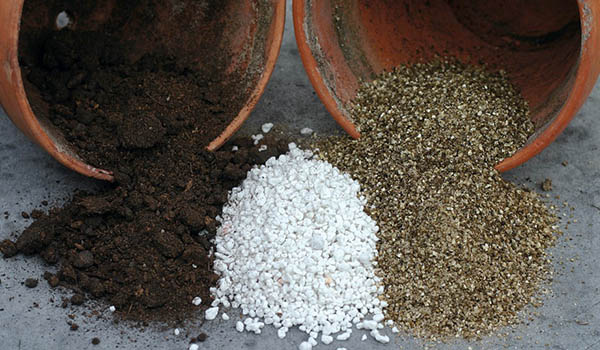

Before planting, the soil is disinfected in one of the available ways:
- spill phytosporin solution or potassium permanganate of medium concentration;
- calcined for half an hour in the oven;
- stand for 30 minutes for a couple.
Important... Pre-treatment of the soil will avoid damage to the bulb by soil pests and reduce the risk of fungal diseases.
Diseases and pests
Like any other plant, this flower can be affected by various diseases and pests. The following are most common when growing hyacinths in pots.
Yellow bacterial rot
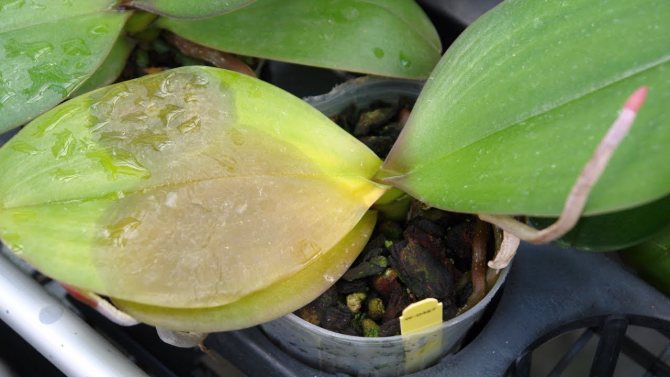

With the disease, the leaves of the plant are affected, and then the bulbs (in the photo is an orchid)
The disease is accompanied by liquefaction of the bulb, a pronounced unpleasant odor, and cessation of plant growth. At the initial stage of the lesion with yellow rot, gray spots appear on the leaves.
Parasitic apical rot
The disease is caused by pathogenic microorganisms in the contaminated soil. Signs of illness:
- brown shallow depressions on flowers and leaves;
- the tips of the leaves are covered with mycelium, become thinner and destroyed;
- roots rot.
Decay processes are accelerated when the air temperature rises.
Mosaic
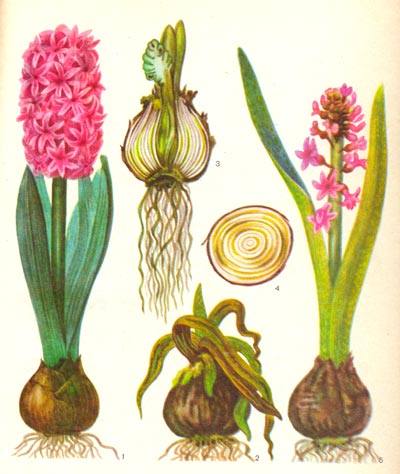

First the leaves dry out, and then the whole plant
Chaotically spaced elongated light green spots appear on leaves and flowers. The affected areas begin to turn yellow and dry. Plant growth slows down. Death is possible.
Gray rot
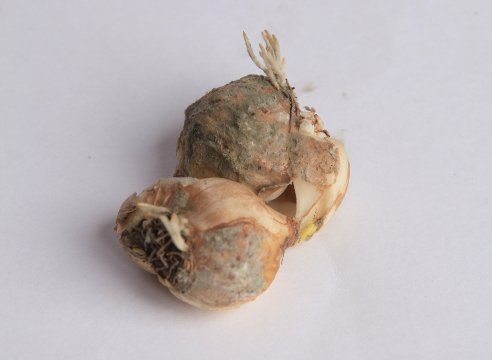

Gray rot leads to the death of the bulbs (pictured is a tulip bulb)
Most often it affects plants during the period of the beginning of growth. The disease is characterized by the formation of yellow spots, which gradually increase in size and acquire a brown color. Rotting of the roots begins quite quickly. The plant dies.
Pests
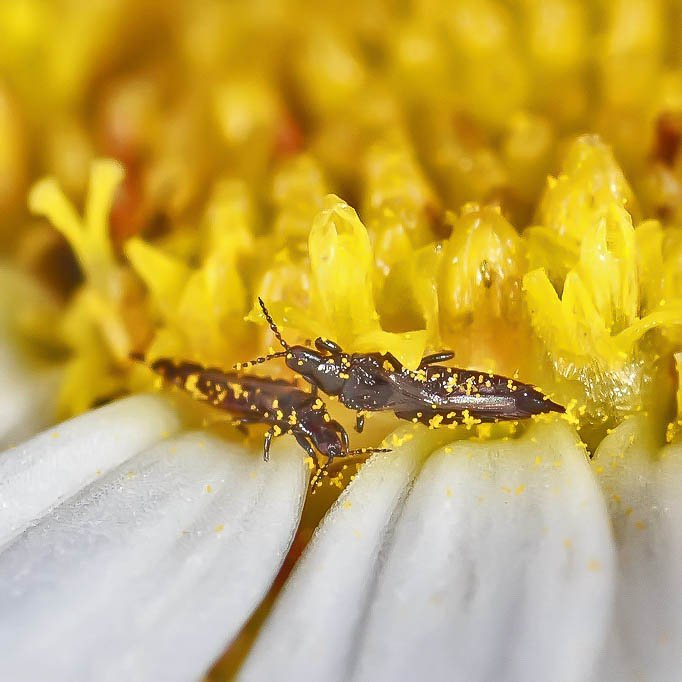

One of the parasites of hyacinths is tobacco thrips
When grown outdoors, the most dangerous pests for hyacinths are aphids and thrips. They take sap from the plant, which leads to the drying of flowers and leaves. For the prevention of damage, spraying with aphicides is carried out. The most effective are Fitoverm, Akarin, Akkord.
Plants grown in pots and outdoors can suffer from nematode infestation. These parasites are of two types: stem and gall. Most often, the first are found, parasitizing on all parts of the plant, ground and underground. At the same time, the bulbs soften, the growth of the hyacinth gradually stops.
There are no radical measures to combat these parasites. On sale there is the only drug to which nematodes are sensitive - "Fitoverm". It is used as a therapeutic and prophylactic agent. Before planting on the soil, pour the powder of this preparation in a thin layer and mix it with the ground to a depth of at least 15 cm.
Possible problems when growing hyacinths: table
A novice florist will be helped by a table of possible mistakes when growing hyacinths in a pot and ways to correct them.
| Problem | Cause | Decision |
| Growth of green mass in the absence of flowering | Small onion | Select an onion with a diameter of at least 5 cm and plant it |
| Different flowering periods of plants of the same variety with simultaneous planting of several bulbs in one pot | All bulbs planted in the same container should be of approximately the same diameter. | Select bulbs with a diameter of at least 5 cm |
| Slow growth, weak flowering | The "cold" period before planting the bulb has not been sustained; the pot is moved to a warm place before the first shoots appear | Correctly prepare a new bulb for planting, following the instructions above |
| Deformed flowers or lack of them | The temperature in the "cold" period was above + 9 ° С | Prepare a new bulb correctly for planting |
| Yellowing of leaves, slow growth | Insufficient watering, poor lighting | Water the plant in a timely manner, move the pot to a well-lit place |
| Falling buds, bulb rot | Excessive watering with water getting into the axils of the leaves and on the buds | Water the plant at the root, at the edge of the pot |
Top dressing and fertilizers
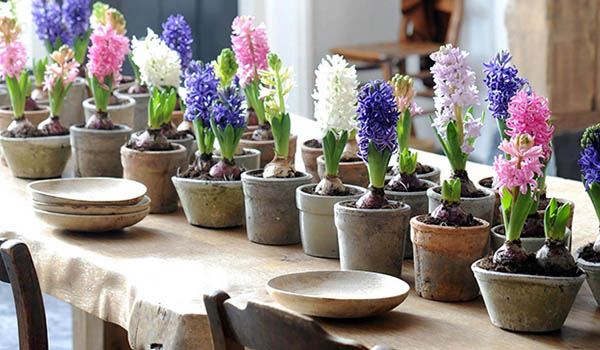

Beautiful bloom of hyacinths impossible without regular fertilization, which are used as complex mineral additives for flowering or bulbous plants:
- top dressing begins with the growth of leaves, introducing mineral additives into the soil containing increased amount of nitrogen;
- further, until the end of flowering, fertilization make 2 times a month, always after watering.
Advice! At the budding stage and during flowering, one of the dressings is replaced by the introduction of a drug that stimulates flowering.
Planting hyacinth seeds is an easy way to breed a new variety
The easiest way to propagate hyacinth is by individual children or by cutting a leaf. Planting with seeds will give you the opportunity to experiment with varieties, but this is a long process, and a new plant will bloom only after 5-6 years.
The soil for sowing hyacinths with seeds is the same as for planting bulbs, but the substrate is carefully crushed so that there are no large lumps. Seedlings are rather weak and grow slowly. Drainage is laid at the bottom of the box, soil is poured, grooves are made in it and seeds are laid out, deepening them by 1.5-2 cm. They are sown in boxes rather thickly - about 160-200 pieces per square meter. The earth is moistened, trying not to erode, and cover from drying out.
Important! In order for the seeds to hatch, they need to go through vernalization. In the open field, it takes place naturally when sowing seeds in the fall, and in a potted culture, the florist will have to create such conditions artificially.
This can be done in two ways - by placing the landing box in the snow or on the top shelf of the refrigerator. The vernalization process takes at least three months. Then the seedling box is transferred to heat.
Shoots appear in the spring. They take root slowly, so all care is carried out very carefully. It is as follows:
- regular watering with small doses of settled melt or rain water;
- loosening the top layer of the earth;
- providing bright lighting, but not direct sunlight;
- protection against mechanical damage.
Once every two weeks, seedlings are fed with a complex mineral fertilizer for bulbous plants. The grown seedlings, if necessary, are cut off, cutting off the weakest and overly thickening specimens with small sharp scissors.
A year later, hyacinth seedlings are planted in separate containers.
Hydroponic Secrets for Hyacinth
This method is simple and allows you to decorate boring winter windowsills not only with bright buds, but also with beautiful vases. Suitable containers for forcing hyacinths in water are available from specialized stores. The middle part of such vases is strongly narrowed.
Advice! Choose transparent containers so that the water level and its purity are clearly visible. After flowering, the vases are used for forcing onions onto a feather. Instead of special containers, cut plastic containers of a suitable size are suitable.
To get blooming hyacinth in water, you need a large, dense bulb that has passed a dormant period. It is placed in the bottom in the wide upper part, and cooled boiled water is poured into the lower part. The liquid should reach the bottom, but not touch it, so as not to cause decay. Vases with bulbs are placed in a dark, cool place until the roots appear. It is necessary to constantly monitor the water level in the container and its purity, and do not forget to top up to the required level.
After the roots appear, the bulbs are rearranged on the windowsill and covered with white paper caps. After a while, shoots will hatch at the top of the onions. When they reach a height of 5–6 cm, the caps are removed. Hyacinths bloom on average three months after the start of root formation.
Hyacinths need nutrients to grow and bud in water. Fertilizers for hydroponic systems are sold at seed stores. It is not recommended to exceed the recommended dosages. This will not result in a more lush and longer flowering, but it can cause rotting of the bulb.
Bulb selection and distillation of hyacinths


With artificial cultivation, hyacinth can make it bloom on a specific date... This process is called forcing. For its implementation, it is necessary to purchase and prepare planting material, substrate and containers in advance.
For distillation use extra-class bulbsdiffering:
- large (from 5 cm in diameter) in size;
- density;
- smooth, without dents and bulges, surface;
- uniform color of flakes, excluding the presence of spots, blotches and plaque.
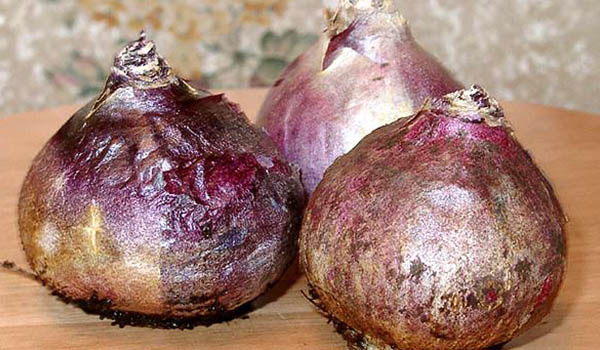

The forcing onion should be small (1.5 times the diameter of the onion) smooth and dry bottom, testifying to her youth, and the rudiment of a cone-shaped sprout.
- Preparation of planting material: before planting the bulbs are soaked for 1-2 hours in a weak solution of potassium permanganate, phytosporin (1 teaspoon per liter of water at room temperature) or any fungicide (Maxim, Vitaros), and then dried. After that, the bulbs for 2 or weeks placed in a cool (5-7, maximum 8 ° C) place, for example, on the bottom shelf of the refrigerator.
- Capacities: forcing hyacinths is convenient to carry out in small plastic pots 10-12 cm high, with drain holes and a drainage compartment. Clay and ceramic containers are not suitable, since the porous structure of their walls contributes to the rapid cooling of the soil, which is fraught with rotting of the bulb.
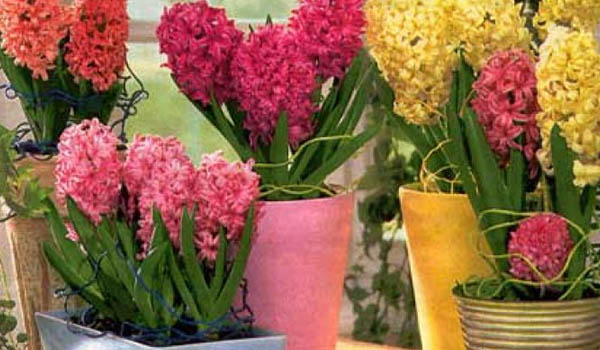

- The composition of the soil is selected based on the plans of the grower:
- an onion used only for forcing, can be planted in any substrateable to hold the roots. For a single flowering, her own supply of nutrients is enough;
- in all cases involving the use of the bulb after distillation, planting is carried out in a nutrient mixture.
Forcing at home: step by step instructions
The process of home forcing hyacinths is carried out according to the following scheme:
- Planting: the container is filled with a substrate, not getting enough sleep to the brim 1-1.5 cm, one or more (3-5 pieces) bulbs are placed on its surface at a distance of 1.5-2 cm, slightly (no more than 2/3) pressing the bottom into the soil.
- Watering: carried out immediately after planting, along the edge of the pot or from the bottom, through the pallet, water should not fall on the bulb. If the soil settles after watering, it is filled up.
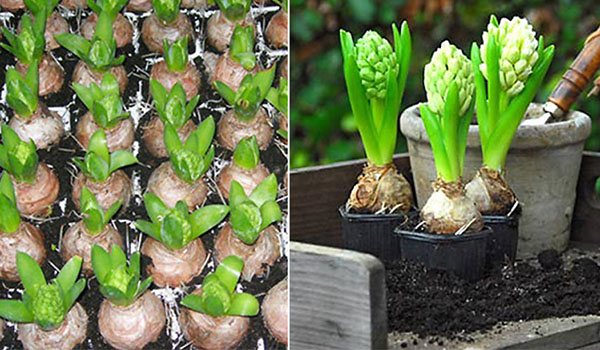

- Rooting: for the growth of roots and leaves hyacinths need coolness and darkening, so the container with the bulbs is covered with thick dark paper and placed in a cool (5-9 degrees above zero) place for 40-45 days. The containers are periodically inspected and the soil is checked for moisture. Can't be allowed both its drying out and waterlogging... During this time, the flower should form roots and grow leaves 2.5-3 cm long.
- After 40-45 days, the flower gradually, without removing the protective cap, transferred to a warm (12-15 ° C) place and kept in this form for 10 days. To light, as well as to heat, they adapt gradually, this is important for the acquisition of the growth of the peduncle and forming a bud of the correct shape and rich color.
- On the 11th day, the plant is moved to a permanent, light and warm (16-20 maximum 23 ° C) place. Within a month, the hyacinth will form flower arrow with bud and bloom.
This video shows how to distill hyacinths at home.
How to get flowers at the right time
Many are interested in the question of how to get hyacinths to bloom for a certain time. To do this, you must first carry out some calculations and determine the start date of distillation:
- from the estimated date of the beginning of flowering counting back 2-3 weeks to keep the bulbs cool;
- to the resulting date add 40-45 days for germination in the dark;
- add 10 days to be kept in a warmer and darker place;
- month to form a flower arrow with a bud.
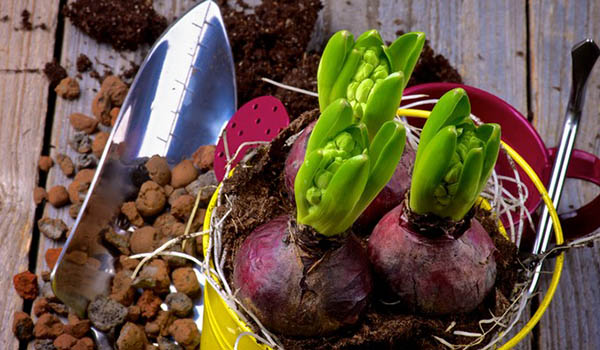

The result is 3-3.5 months. It means that if desired, get hyacinth bloom by March 8, forcing must begin no later than mid-November, and if you plan to present a blooming hyacinth as a gift on Valentine's Day - late October, early November.
Flowering and resting period
The seasonal care and “life calendar” of hyacinth is different from other plants. Flowers bloom when an amateur florist who grows an amazing plant at home wants. Hyacinths are distilled for various holidays: Valentine's Day, Women's Day, Christmas, February 23rd. Depending on the expected date of flowering, spring and active growth for hyacinth are different: for example, to get spectacular buds for Christmas, germination (forcing) of the bulbs begins in September.
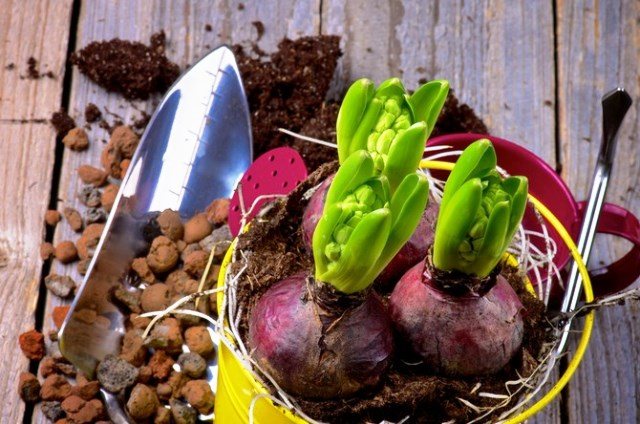

Care during the formation of buds
Faded buds must be removed without damaging neighboring elements. With the right approach, Hyacinth blooms for almost a month. It is imperative to add liquid products (mineral fertilizers) for bulbous plants.
Hyacinth care after flowering
Faded hyacinths are often thrown away, believing that this is a plant of one flowering. However, it is not, after flowering, the life of a hyacinth does not end, even if he got rid of the leaves and is only a bulb.
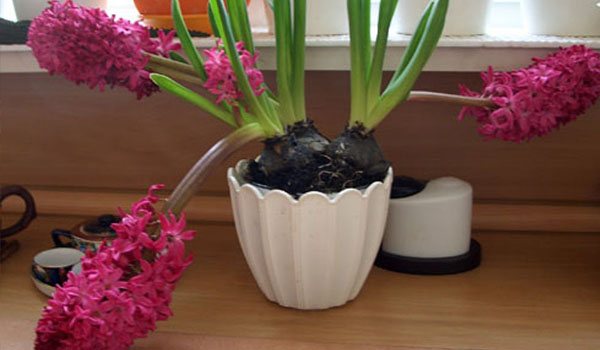

Possible 2 scenarios for flower care after its flowering:
- classic care;
- growing.
Classic care (the method is simple, but far from always effective, often the bulbs dry out and become unsuitable for planting), suggesting:
- peduncle pruning;
- stopping feeding and moistening the soil until the leaves dry and cutting them at a distance of 1 cm from the top of the bulb;
- removing the bulbs from the pot, freeing them from the ground (you can rinse) and the upper dark scales naturally leaving;
- disinfection with fundozol solution (according to the instructions) or potassium permanganate of low concentration and drying for a week at room temperature;
- storage in bags made of thick paper or boxes with sawdust for 2-3 months in a dark, dry and cool (13-15, maximum 17 degrees Celsius) place.
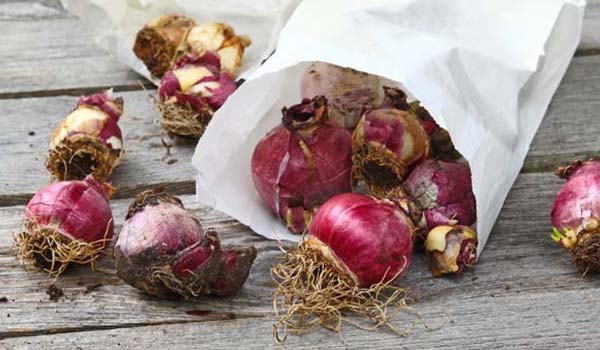

Reference! To avoid drying out, the stored bulbs are checked once a month and sprayed with a weakly concentrated solution of phosphorus-potassium fertilizers.
An alternative method suggested by indoor floriculture practitioners is hyacinth cultivation. For this:
- after cutting the peduncle, the plant is transplanted by the transfer method into a new, more spacious pot filled with fresh nutrient mixture;
- the container with the plant is placed in light coolness (up to 20 ° C), regularly watered and fed.
In areas with a warm climate, the hyacinth that has grown stronger after growing can be transplanted into open ground. If this is not possible, then it is better to place the flower in a light cool: on a balcony or loggia, in a room, trying to create conditions as close as possible to natural. Over the summer, the bulb will gain strength and will repeat flowering next spring.
This video provides tips on how to properly preserve hyacinth bulbs.
In areas with a warm climate, hyacinth that has grown stronger after growing can be transplanted into open ground.
If this is not possible, then it is better to place the flower in a light cool: on the balcony or loggia, in the room, trying to create conditions as close to natural as possible. Over the summer, the bulb will gain strength and next spring will bloom againe.
The purchased flower was brought home, how should you care for it?
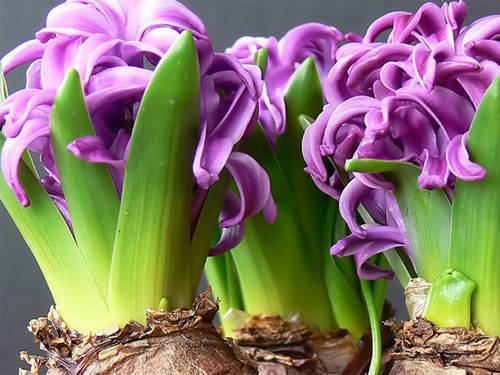

Usually, blooming hyacinths are not transplanted, but this rule does not apply to plants purchased in garden stores.
The hyacinth bulb can be purchased at any time of the year. If there is no intention to immediately send it for distillation, then place it in a cool place for storage at a temperature of 6–9 ° C. This will halt growth processes and initiate a period of dormancy. If a potted bulb is purchased, it is placed in a well-lit area for forcing.
Is it worth replanting from a store pot
As for whether it is necessary to transplant hyacinth from a store pot, the opinions of flower growers differ. Some believe that it is undesirable to injure the flower with a transplant. Others do not see any danger to the plant in this process. In order to decide what to do next, the situation is assessed according to several parameters:
- flower condition: rooted bulb, there are sprouts, blooms;
- pot size;
- what will be done with the plant after it has faded.
Most often, hyacinths are sold in their best marketable form: flowering. At the same time, the bulbs are planted in such small containers that the soil is almost invisible. Vegetation of plants in such conditions is supported by watering with chemicals. As soon as this process stops, the flower may die. Therefore, in order to preserve the life of a flower, after purchase, hyacinth must be transplanted into a pot with soil, regardless of whether it blooms or not. If it is purchased in a container with a sufficient amount of substrate, it is better to refrain from transplanting. After the hyacinth has faded, the bulb is dug up and sent to a dormant period.
Recent Entries
Rose Petal Jam and Its 7 Health Benefits You Likely Didn't Know About What Fruit Are You According to the Zodiac Sign The 11 Best Grape Varieties That Will Help You Create Unique Homemade Wine
Conditions for growing hyacinth in a pot
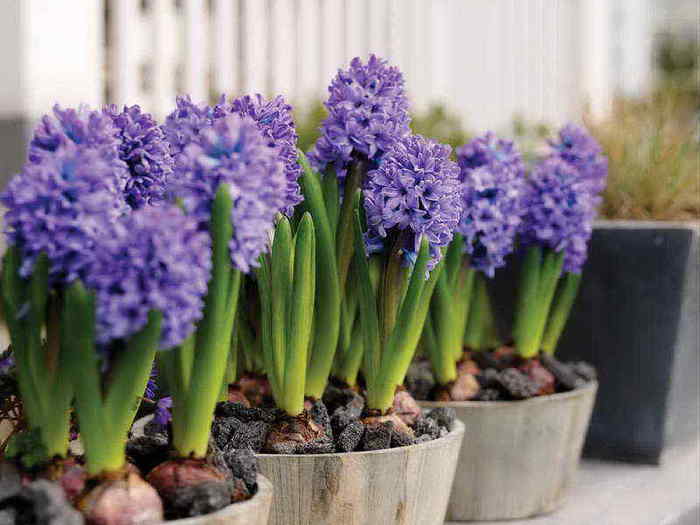

Try not to put hyacinths on windowsills where there is a high probability of drying out from radiators
The hyacinth pot is placed in any bright, warm place. Closeness to heating devices is undesirable: radiators and various heaters. For normal vegetation, the plant needs room temperature.
During the ripening period of the buds, hyacinth can be illuminated in the evenings with an incandescent or fluorescent lamp. The optimum temperature for flowering is 20 ° C. Watering should be moderate but constant. Do not allow the soil to dry out. It is important to exclude the ingress of water on the top of the bulb and in the leaf axils.
Therefore, water is poured at the edge of the pot. This will inevitably cause gradual erosion of the substrate. In order to avoid this, the container with the flower is periodically turned. It is also useful for the stem of the plant to grow upright. If necessary (if the soil is not nutritious enough), fertilizing with mineral fertilizers is possible.
The conditions listed above are considered ideal for growing hyacinths in a pot. But it is not always possible to provide them.However, do not worry about this: hyacinth is quite unpretentious and will definitely bloom at room temperature and normal room lighting.
How many times does hyacinth bloom
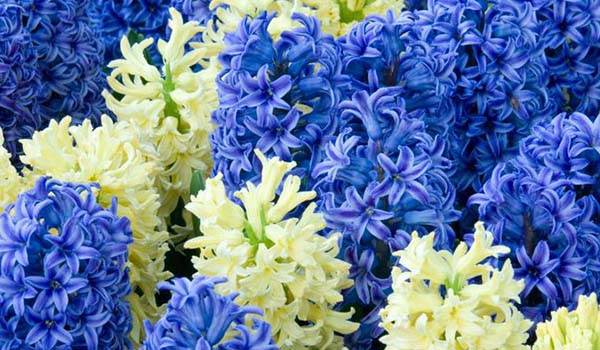

In the natural environment hyacinth blooms annually... When grown indoors, it can be made to bloom more often - 2 times a year, but experienced florists do not recommend doing this.
A bulb weakened by two flowering may refuse to bloom next year, or die of exhaustion.
Useful properties of hyacinth
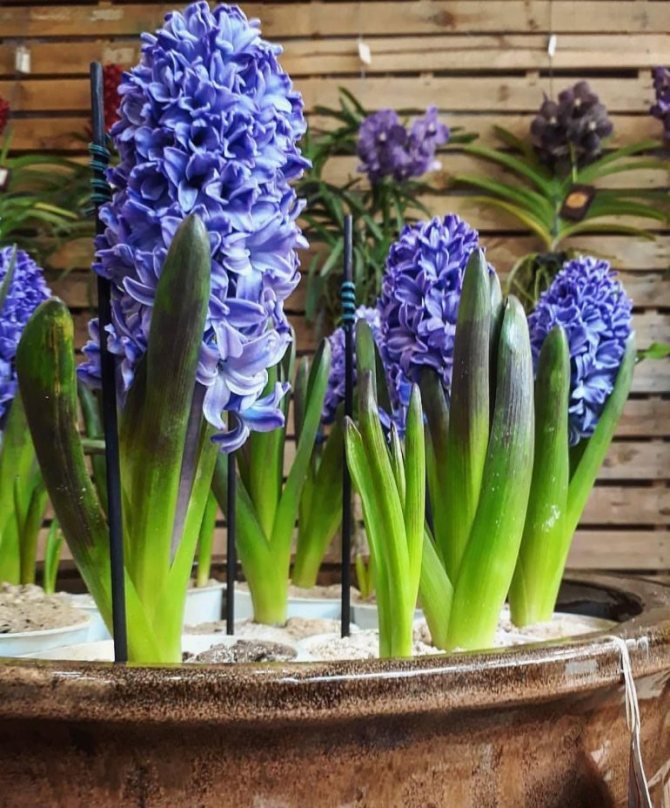

The dried hyacinth petals are filled into a sachet to flavor bed linen. Things perfumed in this way keep the smell of freshness and cleanliness for a long time. Hyacinth is believed to emit strong energy that spirals from the roots to the top tier of flowers. The plant improves general condition and improves mood. But the smell can cause a headache, so the flower is not recommended to be placed in the bedroom and children's room.
Possible problems of growing hyacinths
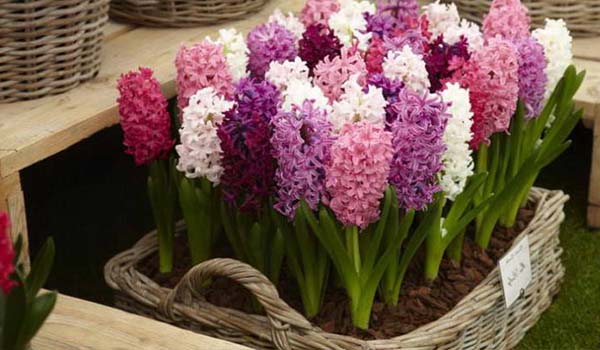

When growing hyacinths difficulties are possible, which the plant will signal a change in appearance.
| Signs of trouble | Possible reasons |
| 1. Slow growth of leaves, no flower arrow or her late exit |
|
| 2. Lethargy leaves |
|
| 3. Flashing leaves |
|
| 4. Short or crooked peduncle |
|
What to do with hyacinth after purchase
Growers disagree on whether or not to transplant a blooming hyacinth just bought from a store.
Plants are sold in cramped pots, in which there is too little space for the bulb, there is not enough nutrient substrate, and the soil dries out too quickly. Therefore, if you see the need for a plant transplant, you can carefully carry it out. To do this, thoroughly moisten the soil in which the plant is located and carefully transfer the bulb to a larger pot. Cover with earth, without deepening the neck of the bulb.
After transplanting into a more spacious container, the plant not only looks better, but also becomes easier to care for. After flowering, it can be grown in the same pot.
How to grow hyacinth from a bulb in a pot
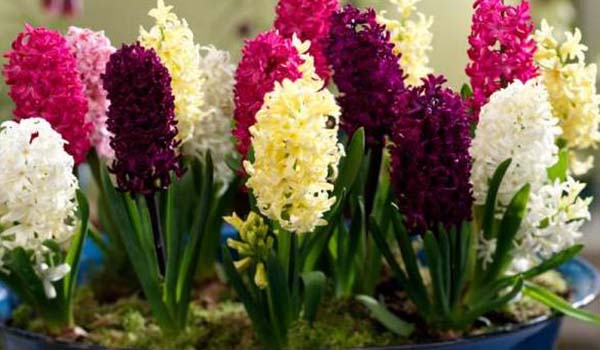

Growing hyacinth bulbs in a pot, carried out at home, has a lot to do with distillation... It begins with the acquisition of planting material or, more often, a flowering plant.
reference... Growing an acquired flowering plant comes down to providing it with good lighting, observing the temperature regime, watering and feeding. Leaving after flowering is carried out according to one of the scenarios described above.
How to properly plant hyacinth in a pot
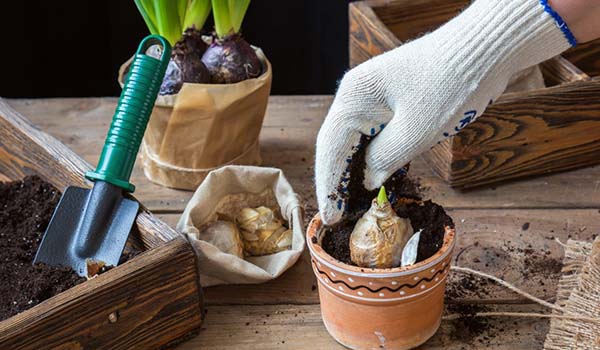

Planting bulbs when grown in the usual way by carrying out according to a scheme similar to distillationconsidering 2 nuances:
- landing time is calculatedso that flowering occurs in early spring: March, April;
- the bulbs are planted in more spacious ones than for forcing, plastic pots.
Landing scheme:
- placed on the bottom of the container small drainage layer, as which you can use fine expanded clay, sphagnum or sand;
- a nutritious soil is poured over the drainage, without adding 1.5-2.5 cm to the edges of the pot;
- the bulb is placed on the surface of the soil and slightly (2/3) pressed into it.
How to water
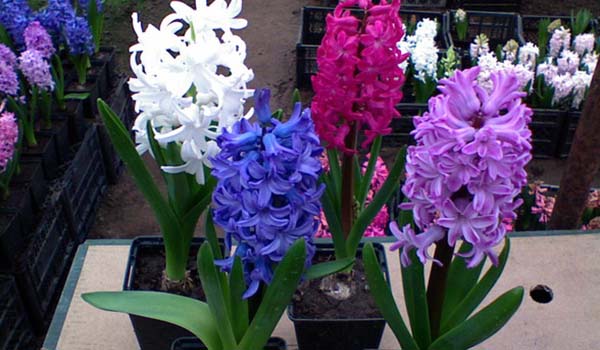

After planting, the bulbs are watered. It is convenient to do it from a watering can with a long spoutby directing the stream along the edge of the pot and keeping moisture out of the surface.
Moistening the soil is carried out regularly, preventing the earthen lump from drying out and the accumulation of water in the pan.
Care and features of growing a flower
Subject to the recommendations, hyacinths will certainly release flower stalks on which buds are formed. The duration and quality of flowering, the condition of the bulbs, which can be used for reproduction and growing of "babies", depend on proper care.
Location and choice of flowerpot
The plant loves light, but heat is not needed. For this reason, do not put a flowerpot with a flower plant on the southern windowsills.
Where to place the plant? It is important that the hyacinth is not in a draft. In a too cold and damp room, flowering is unlikely to be abundant, there is a high risk of wilting of leaves and rotting.
Content temperature and humidity
Optimum performance is from +22 to +24 degrees. Hyacinths do not tolerate heat well; when grown in winter, the plants must be protected from the hot, dry air emanating from the central heating batteries. For this reason, you should not place the flowerpot on the windowsill in winter, it is better to buy a decorative stand.
Watering and spraying
On a note:
- The hyacinth is often called the "rain flower". It is important that the soil is always moist, but in moderation.
- When watering, liquid is added from the edges, making sure that drops do not fall into the center of the outlet, on the bulb and buds.
- Stagnation of moisture interferes with development, provokes rotting of the bulbs and roots. Always drain the liquid from the sump.
- Top dressing and fertilization is one of the types of hyacinth care during the flowering period. A solution of calcium nitrate 0.2% is an excellent tool for preserving buds for a long time. Liquid fertilizers are applied to wet soil. If necessary, dilute the product according to the instructions.
- The frequency of watering is determined by the state of the earthen coma and the surface of the substrate: there should be no dried out zones, but water in the soil is also a sign of improper plant care.
Lighting and supplementary lighting
Short daylight hours after bud formation interferes with long flowering. It is useful to supplement a beautifully blooming view with a fluorescent ramp. Hyacinth loves a good level of light, but the scorching rays are harmful.
How long does hyacinth live in a pot
Many doubt whether it is a perennial or annual hyacinth flower. In its natural environment, this plant grows like a perennial and with good care, pleases with its flowering about 10 years.
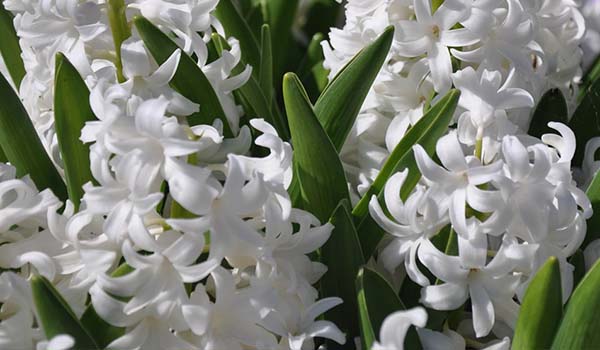

When grown at home, its life is much shorter:
- After distillation, many get rid of the bulb, since it is troublesome to store or grow the flower.
- With normal cultivation the plant lives in a pot for several yearsuntil the bulb is old.
Adults (3-4 years old) hyacinth bulbs form babies, which are separated and used for procreation of the flower variety you like.
Many growers will agree that hyacinth is not so easy to grow and make it bloom in indoor conditions. To do this, you need to study special literature, be patient, be attentive to the plant and pedantic follow all recommendations.
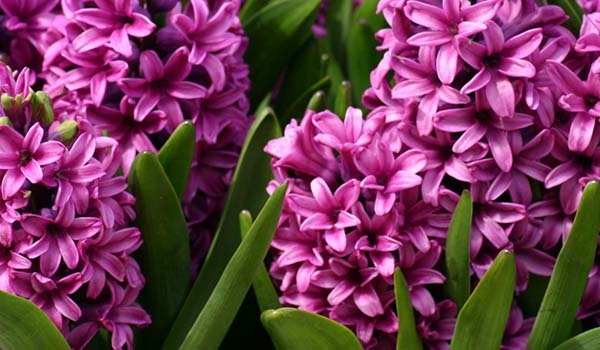

However, the result is worth it both from a decorative point of view and as proof that much is subject to the work of human hands.
Reproduction methods
There are several ways to breed Hyacinth. Among them: reproduction by children, propagation by seeds, cutting out the bottom and notching the bottom... At home, the first method is most often used, since the rest are very lengthy and complex, they are used by breeders and professionals.
On average, a bulb can form 2-4 babies per year. They must be carefully separated from the mother bulb and planted in a separate container. If the baby is difficult to separate, then after a period of rest, the mother's bulb is planted with it and it is separated only after the next flowering of the Hyacinth.
With this method of reproduction, the plant blooms in 2-3 years.
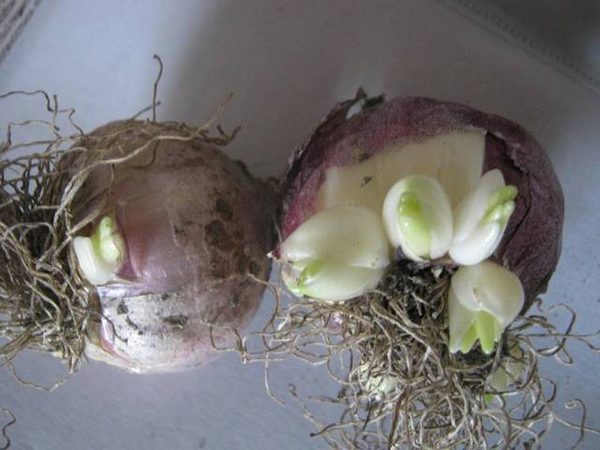

Hyacinth bulb with babies
How to prepare the soil and choose a planting site
Hyacinths are perennial bulbous plants that need a lot of warmth, enough moisture, and an enriched soil to grow well.
The best place to grow these flowers is considered to be open, sunny, sheltered from the wind.
A flowering culture requires regular watering, but it is still not recommended to plant hyacinths in areas with high groundwater levels.
In these places, moisture can collect and stagnate, which leads to the disease of the bulb with fungi. Gardeners advise in such cases to drain before planting or plant hyacinths in the beds in flower containers.
Hyacinths develop well in gardens where the soil is enriched with organic matter. The soil for flowers is prepared in advance.
A few months before the autumn planting of bulbs or seeds, the ground must be dug up and filled with humus, potassium salt and superphosphate. You can apply fertilizer to the entire area of the garden or add it directly to the holes.
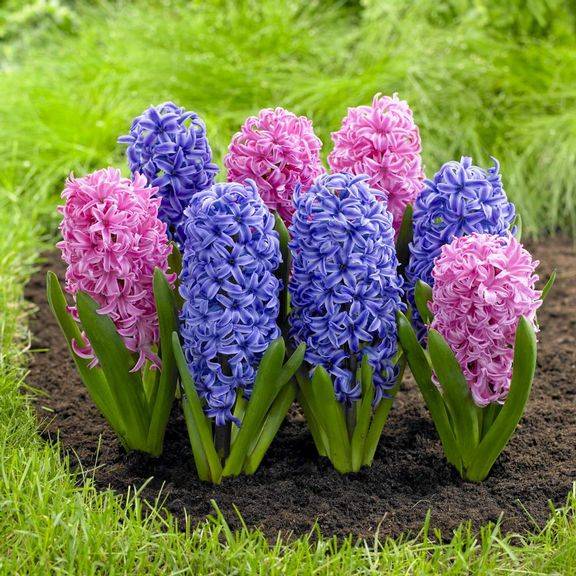

Lime and chalk should be added to the soil with high acidity, and heavy soils are diluted with sand. After adding all the necessary components, the beds are covered with a film material to prevent weed growth.
In the southern strip, cultivation of hyacinths in the open field is carried out in mid-autumn, and in mid-latitudes - in early September.
You should not plant the bulbs in advance, as they take root rather quickly in the heat and begin to sprout, which leads to freezing in the winter.
Also, late planted flowers do not have time to take root before the cold weather and often do not tolerate winter frosts.
Reproduction
Hyacinth cultivation is extremely slow. Basically, to speed up the reproduction process, they resort to stimulating the bulbs in the following ways:
- Cutting the bottom. The large bulbs are dug up, washed and dried. After 7 days, the roots begin to fall off, then an incision is made with a wedge with a sharp knife, the bottom and the kidney are removed. After the planting material is laid with a cut up in a container, sprinkled with coal and covered with a bag. After 3 months, the rudiments of roots and sprouts appear.
- Scales. The onion is divided into 4 parts and the scales are broken off from below. Fold in a bag of sand. They hold it for a month and a half at +22 degrees and the same amount at +18.
- Cutting the bottom. An incision in the shape of a cross is made at the bottom, sprinkled with coal and left in a warm room. As a result, 15 new bulbs appear.
- Cuttings. It is carried out when there is a bud on a flower. They take two leaves at the very base and plant them in an average container with coarse sand 4 cm. It is placed in a strong plastic bag and kept warm at high humidity.
How to choose and prepare bulbs
Before growing hyacinth in the garden, it is important to learn how to select healthy and strong tubers. For planting in the ground or a pot, take medium-sized hyacinths. They must be tight and free from damage.
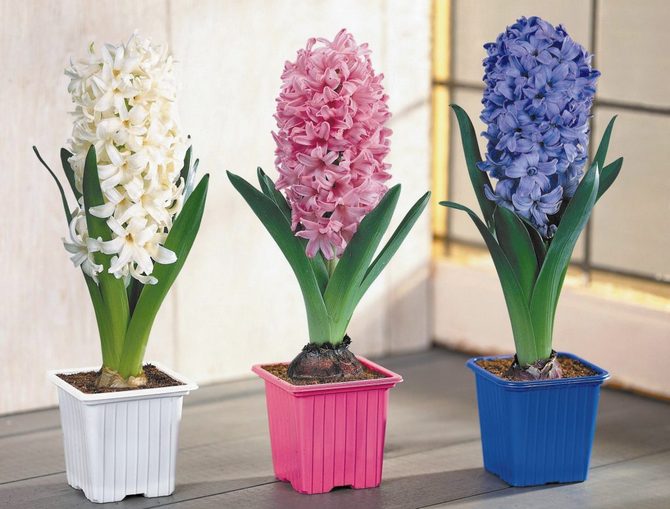

What do hyacinths look like
The scales on the surface of the bulb should adhere tightly to each other, their color should be darker than the color of the flower.
Important! An important indicator of a healthy bulb is the bottom-to-bulb ratio. It amounts to 1 to 1.6.
How to determine the age of a hyacinth by bulb size
| Bulb size | Age |
| 2-3 cm | Young, just formed from children |
| 4-5 cm | Adults producing good stalks |
| 6-7 cm | Old bulbs in need of renewal |
Before planting, the planting material is examined, dried scales are removed. Immediately before planting, hyacinths must be disinfected in a weak solution of potassium permanganate or a purchased fungicide.
Storing hyacinth bulbs
Storage varies between purchased flowering plants and those grown on the plot. In the first case, after flowering, the peduncle is cut off.If the plant grew in a small container, then it is transplanted into a larger pot. After pruning the peduncle and transplanting, the hyacinth is placed in a cool, lighted place. It can be placed against the glass of the window. There he will have enough light, and the temperature will be low.
Watering hyacinth in storage should be done in moderation. In May - June, the preserved bulb is transplanted into a flower garden.
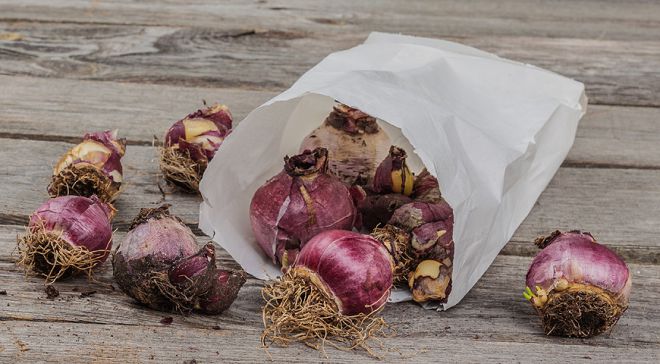

Storage option
Plants growing in the garden are dug up after flowering and replanted in the fall before winter. In summer, the bulbs are stored in a cool, dark place.
Choosing a site for planting
It is advisable to decide in advance on the area where you are going to plant hyacinths. When looking for such a site, you need to take into account several important details that affect the germination of a plant:
- degree of humidity. Despite the fact that hyacinths love moisture, they are not suitable for those territories to which melt water flows. If a flower is flooded in the early stages of growth, it may simply rot and die. That is why raised beds or flower beds are best suited for hyacinths;
- illumination. Hyacinths are considered light-loving plants, and direct contact with the sun's rays allows them to acquire a strong peduncle, on which a large number of bright beautiful flowers appear over time. Of course, you can grow this plant in a shaded flower bed, but its flowering may be less lush;
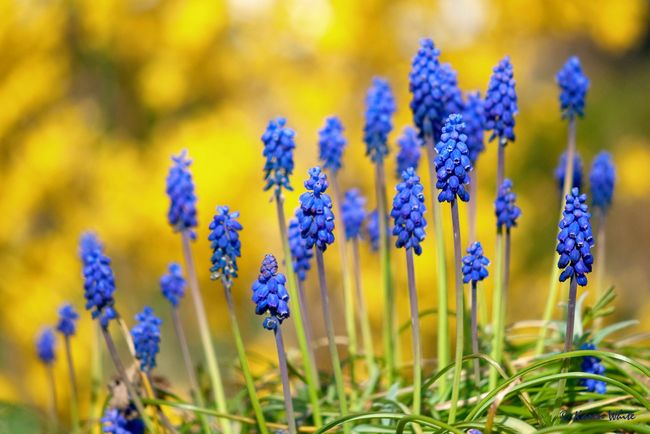

Hyacinths need sunlight to form a strong peduncle - indicators of soil acidity. Acidic soils are completely unsuitable for growing hyacinths. The increased content of humus in the soil with medium acidity is welcomed.
Care rules
The natural habitat of the water hyacinth, or eichornia - Asia, South America. Due to the warm climate, it does not fall into a state of vegetative dormancy in nature. But it was found that she developed such an ability. She can hibernate in wet sand, a greenhouse, or indoor aquarium.
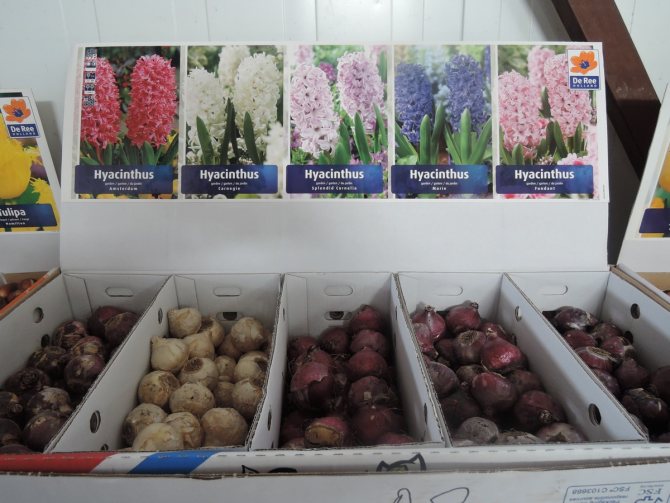

It is planted in May - June. Thanks to its aesthetics and excellent decorative properties, eichornia began to be cultivated for a long time. Today it is actively used in landscape design and aquarium hobby. Demonstrates relative unpretentiousness, high level of adaptability.
Important!
The disadvantage of water hyacinth is its ability to grow. This is not the best choice for composing water flowers.
During the summer, it may be necessary to prune the lateral shoots that form at the base of the leaves to prevent it from dominating its neighbors. Eichornia juice is not poisonous, but it can cause irritation and an allergic reaction on the skin.
Hyacinth flower - description
The perennial hyacinth has a dense bulb, consisting of lower fleshy leaves that occupy the entire circumference of the bottom, the immediate continuation of which is the peduncle. A racemose inflorescence of brightly colored bell-shaped flowers with bent perianth lobes is formed on the stem. After flowering is complete, the stem and the green leaves sitting at its very bottom dry up, but a bud is formed in the corner of the upper leaf, which will become a bulb and give a peduncle the next season. In the corners of other hyacinth leaves, bulbs can also form, which can be separated and grown so that after a few years they also throw out flower arrows. The fruit of the hyacinth looks like a leathery three-nested box, in each nest of which two seeds ripen.
Selection of a place for growing
The main conditions for luxurious flowering:
- sunny, windless place;
- light permeable soil with a neutral pH-reaction;
- exclusion of moisture stagnation.
Having fulfilled the first condition, the rest provide a minimum set of agrotechnical measures:
| heavy, dense soil is broken with a large amount of sand, peat (not horse peat - it increases acidity), compost and / or humus; |
| in too acidic - dolomite flour or lime, in alkalized - peat (horse), phosphogypsum, organic matter (only completely rotted). |
In areas with long standing groundwater after snow melting, flower beds for bulbous plants are made on an elevation, the bottom of the area under the flower bed is lined with a good layer of drainage, only after that soil is poured abundantly with sand.
A complex of potassium-phosphorus fertilizers is applied immediately. It makes no sense to add nitrogen components before winter: in the fall they are contraindicated for hyacinths (they stimulate the growth of green mass), and by the spring there will be nothing left of them (they are washed out by rain and melt water).
Not the last moment - crop rotation.
The ideal option is a bed after zucchini or pumpkins, borage soil.
Siderizing will neutralize any problems, but there are also special preferences - lupine or alfalfa.
Popular varieties
Hybridizers have bred a huge number of varieties with large flowers and heady aroma, differing in the size of the inflorescences, color, height of the peduncle, and the timing of flowering. The most common are:
- Royal Navy. A variety with double flowers of a rich purple hue.
- Brooklyn. Variety with white-yellow-cream colored flowers with a darker center.
- Raphael. A distinctive feature of the variety are semi-open flowers with narrow elongated petals.
- Rosalia. The flowers of this variety of hyacinth are bright pink.
- Ostara. A characteristic feature of the variety is its bright purple inflorescences and a rather long flowering period (about three weeks).
- Woodstock. A purple-lilac hyacinth with a large inflorescence.
- Midnight Mystique. The variety is a find of the last decade. Its characteristic feature is the original flowers of almost black color.
- Carnegie. A variety with gorgeous white flowers.
- Fondant. Delicate pink hyacinth with mother-of-pearl petals.
- Orange Boven. The cultivar boasts salmon-apricot flowers with a yellow throat and dark pink perianth ends.
Photo gallery: varietal variety of hyacinths
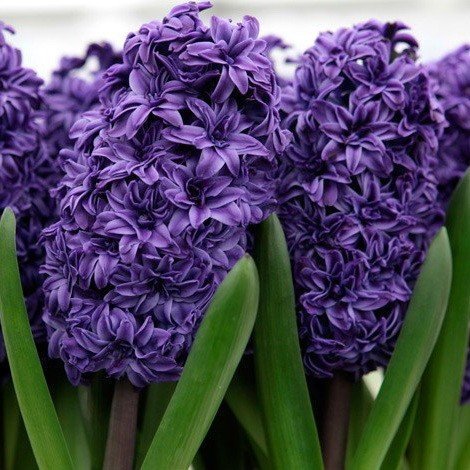

Royal Navy variety - double-flowered hyacinth with a deep purple hue
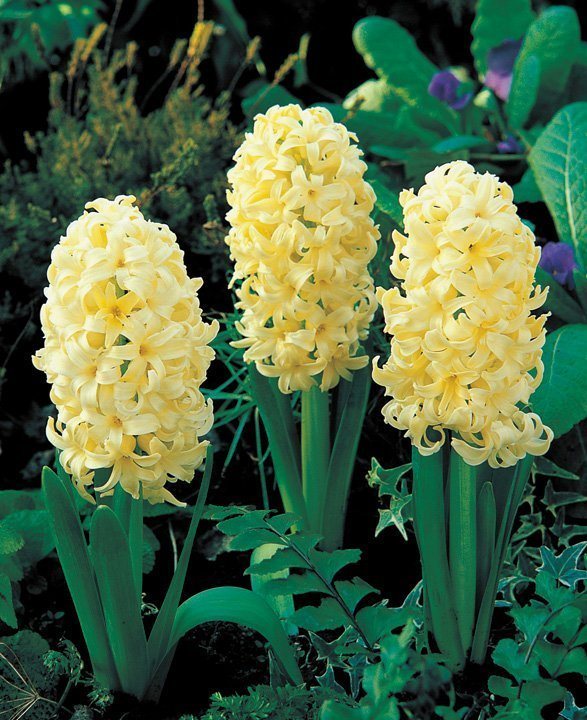

Brooklyn cultivar is a delicate hyacinth with yellowish flowers with a darker color class = "aligncenter" width = "714" height = "1024"
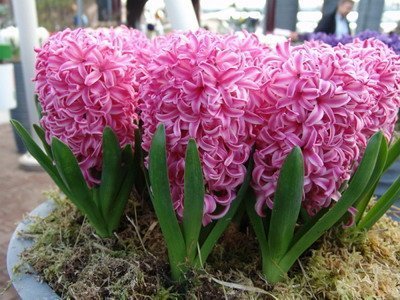

Rosalia hyacinth flowers in bright pink color
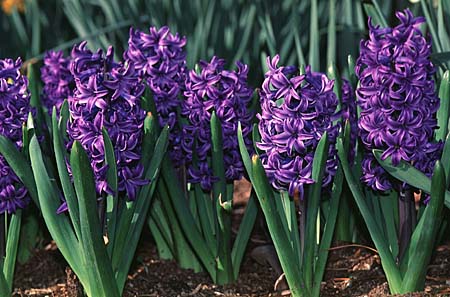

A characteristic feature of the Ostara variety is bright purple inflorescences and a rather long flowering period
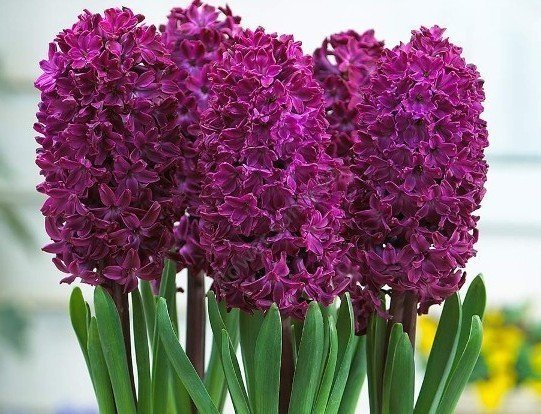

Woodstock cultivar - purple-lilac hyacinth with large inflorescence
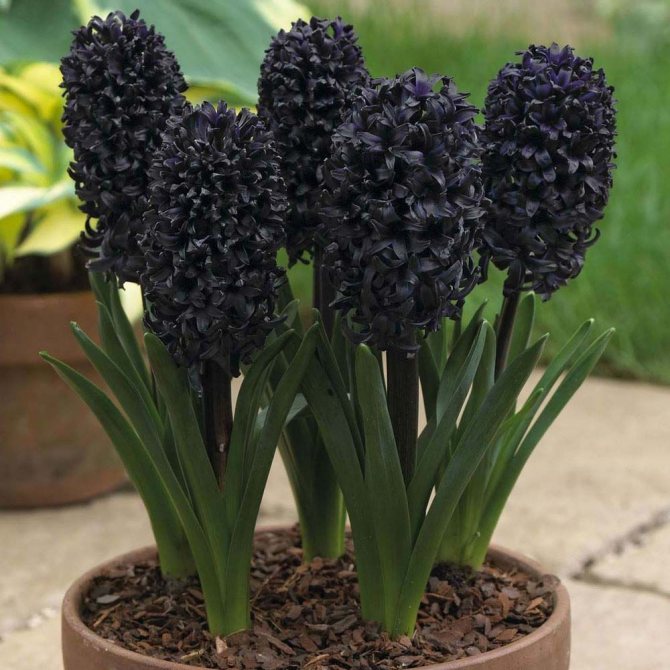

A characteristic feature of the Midnight Mystery variety is the original flowers of almost black color
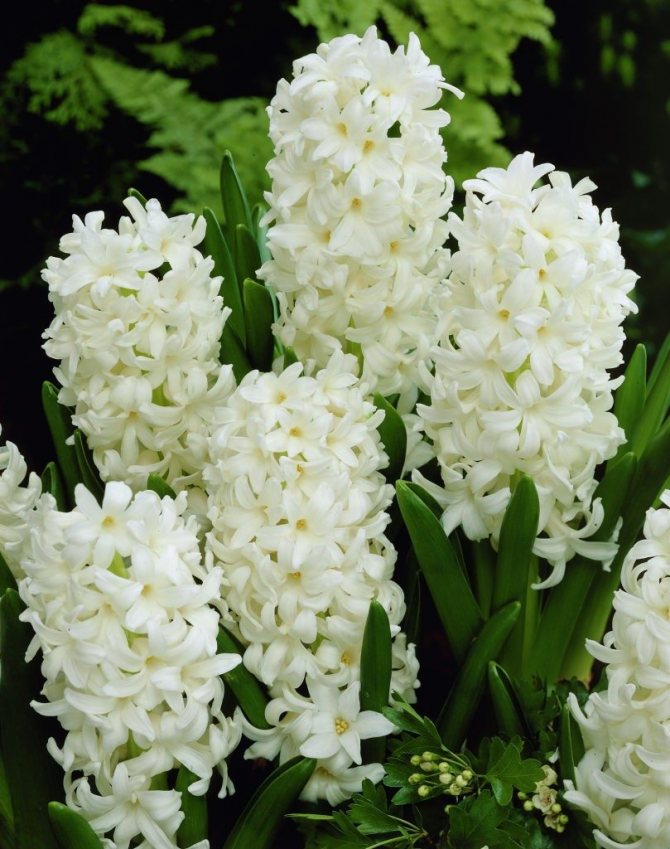

Carnegie - fragrant hyacinth with gorgeous white flowers
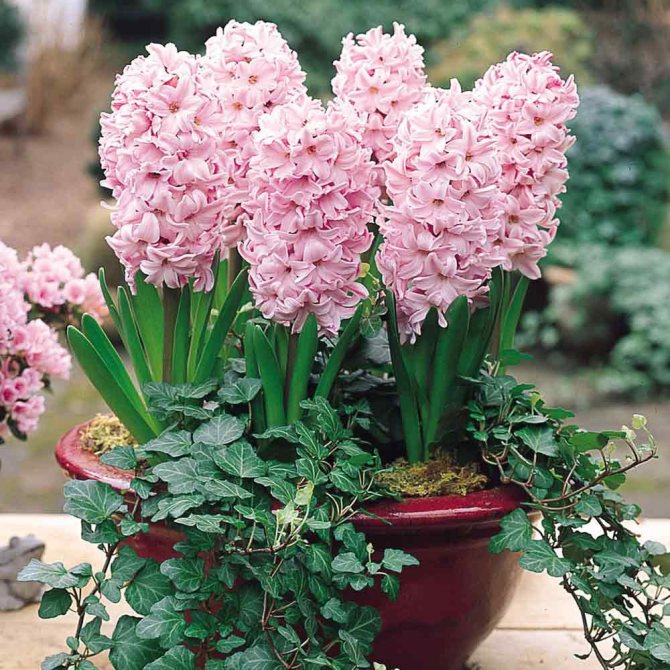

Fondant - a graceful pink hyacinth with mother-of-pearl petals
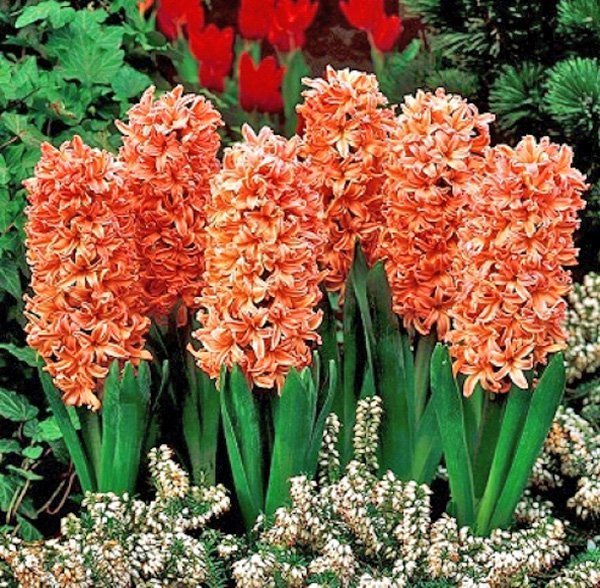

Orange Boven boasts salmon-apricot flowers with a yellow fauces and dark pink perianth tips.
Choosing a place for hyacinths in the garden
Grouse imperial: planting and care in the open field
To grow these flowers in the country or near the house, choose an open area, protected from drafts. The plant should receive a lot of sunlight, but the direct rays of the sun can harm it.
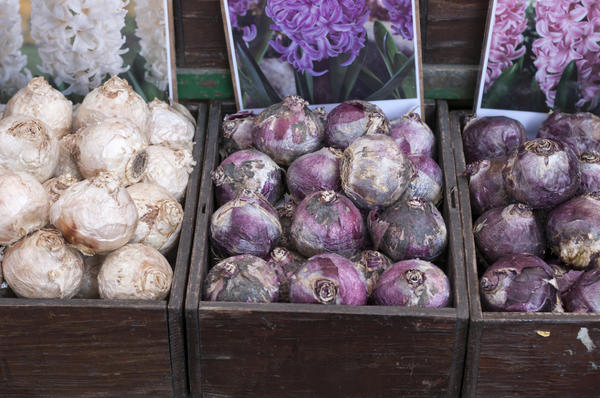

Hyacinth bulbs
Flowers are allowed to be planted under tall trees, but in this case more fertilizers will need to be applied. The flower bed is placed on a hill or a small slope. The surface of the earth is leveled.
Hyacinths grow well in organic-rich soil. The soil should be light, moisture permeable. The landing site is prepared 2-3 months before it.
Important! Bulbs can rot in waterlogged soil. Therefore, in places with high water levels, hyacinths are planted in pots or drainage is used.
Reproduction of hyacinths
In addition to the vegetative reproduction method by children, which we have already described, hyacinths are propagated by the seed method.Hyacinth seeds are sown in boxes with soil consisting of two parts of humus, one part of leafy soil and one part of sand, and the crops are placed in a cold greenhouse, in which they grow hyacinths for two years before planting the bulbs in open ground. However, the seed method does not preserve the varietal characteristics of the parent plants in the offspring, therefore it is suitable only for the propagation of species hyacinths or for breeding new varieties.
Professional growers prefer to propagate hyacinths in such a way as cutting the bottom. A sterile teaspoon with a sharp edge is used as a tool, with which the bottom is cut out, removing the bases of the scaly leaves and leaving the rest of the bulb intact. To avoid the development of infection, the surface of the sections is treated with a fungicide, after which the bulbs are placed with the cut side up on a tray with sterile sand and kept at a temperature of at least 21 ºC pending callus formation. After 65-90 days, from 20 to 40 babies are formed on the cuts of each bulb. These nests are planted in pots so that the children are slightly covered with soil. After two weeks of hardening procedures, the pots are transferred to cold greenhouses. In spring, young bulbs will begin to form leaves, gradually destroying the mother bulb. At the end of the season, young plants are separated and planted for rearing. They will bloom in the third or fourth year.
Diseases of hyacinths
Leaves, inflorescences and bulbs are subject to various diseases:
- fungal;
- bacterial;
- viral.
The most common diseases:
- apical rot - caused by soil pathogens;
- gray mold;
- wet rot;
- bulb rot - bulb penicillosis;
- hyacinth mosaic.
Plant bulbs are stored in a cool, dry place. Particular attention should be paid to bulbs with small round yellow spots under the husk or light brown spots merging with larger spots. The former probably means infection of the bulb with gray mold, the latter - with dry rot. It is better to throw them away, because by putting them back in the ground, we will infect other hyacinths with both fungal diseases. Bulbs should always be treated with a fungicide before planting.
Receiving at the required time
More than a century ago, the Dutch grower Dames found a way to awaken the blooming of hyacinths by the beginning of winter. Nowadays, in stores you can buy pots with blossoming buds already in November. Florists themselves can achieve a similar effect by familiarizing themselves with certain, not too difficult rules.
Forcing the hyacinth to bloom at an uncharacteristic time for it, it is necessary to organize the conditions for overcoming all stages of development inherent in it in the natural environment. The purchased bulbs are already ready for planting, you just need to follow the rules for storing them before planting.
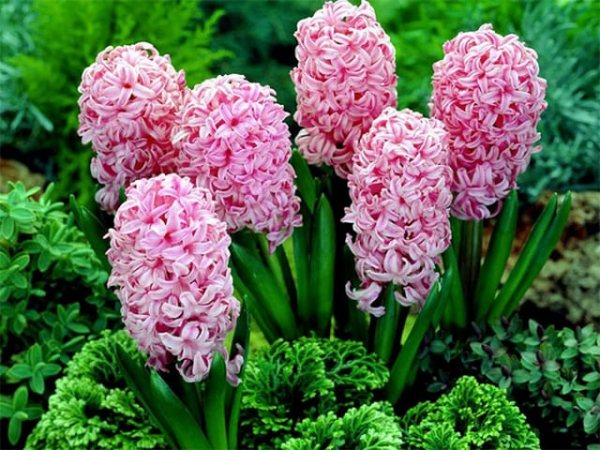

They need darkness and a ventilated room with a temperature of about 17 degrees. When using your own planting material, you must select bulbs of a certain size that require a previous step-by-step preparation.
Forcing for the New Year's holiday in the center of our country requires digging out the bulbs in late June - early July. They are dried at 35 degrees and 75% humidity in order to form kidneys. Store in boxes with holes in the bottom at 17 degrees and ventilation. At high humidity, an unpleasant disease can occur - penicillosis
For distillation in the middle and late periods, which fall from January to April, the bulbs must be dug up a week later, warmed up at a temperature of 25-30 degrees for 60 days, and kept at 17 degrees until disembarkation. For rooting, it must be chilled at 9 degrees, which takes about 3 months.
Varieties are selected according to their flowering period: for early or late distillation. Thermal requirements at all stages of seed preparation for planting should be met as punctually as possible.Departure from them will entail a twisting of the stem or the emergence of inflorescences devoid of color.


After the end of flowering, when the resting phase begins, the most important for the flower is the temperature schedule, economical watering. After the completion of flowering and wilting of the leaves that need to be cut off, the bulbs are dug up and sent for conservation in compliance with all conditions.
Florist reviews
I love the scent of hyacinths! What's most remarkable is that each variety always smells differently! It's just some kind of miracle! But you should not abuse them either, since the aroma does not work favorably on everyone (I will compare it in action with lilies and lilacs), for some it can provoke a headache. So everything is good in moderation. And for lovers of hyacinth plantations - they can be planted in the garden) For lovers of experiments, after flowering, you can send the bulbs to rest in order to achieve the next flowering.
Kuzik 1981
I love these beautiful flowers very much, although I am calm about gardening. I usually plan a distillation for the New Year, but you can, of course, grow such a wonder for any holiday. Stock up on time: it will take 2 to 3 months. I drive the bulbs over the water, it's faster and more beautiful, but there is a great chance that the hyacinth will not bloom later (single use). So after distilling, we put the onion to rest, maybe in a year in the flower bed it will delight you again.
Babika
I can't really take care of flowers, for some reason I have such a feature that I constantly forget to take care of them, that is, transplant, loosen, fertilize and even water ... That is why, probably, they began to give me gifts less and less fresh flowers in pots. And I think that's right. You shouldn't torture such beauty) But this time was an exception) I was presented with two stunningly beautiful flowers, one white and the other purple ... The flowers are very fragrant, as soon as they got into the room, after about twenty minutes it was filled with such a pleasant smell that there was a desire to leave it))) Flowering lasted almost three weeks, not a day of which there was no desire to leave the room with them) This is really a godsend, for people like me ... This small flower attracted my attention to itself and chained it) It was just it is impossible not to look after him)
Geni25
Unlike tulips and daffodils, hyacinth bulbs are stored at room temperature before planting, then planted in pots, kept in a refrigerator at a temperature of 6-9 degrees. You need to take it out when the sprouts become 4–5 cm. How to drive it out exactly for the New Year? It is necessary to take varieties with the shortest cooling period, there are tables with distillation dates. Terry varieties, yellow, apricot varieties are distilled for a long time. Faster blue, mauve, white. Minimum refrigeration time is 10 weeks, with about 18 more days before flowering. Those. you need to plant no later than the first days of October. Yes, and the bulbs should be the largest, 5 cm or more. I planted the Arctic on 10/15/11, took it out of the refrigerator on 12/25/11, it bloomed on 1/11/12.
Florence
Of the plants that bloom at home, I have two favorites on the windowsill - orchid and hyacinth. And if I associate the former with the tropics, the latter with the onset of spring in our area, with the women's holiday on March 8. Hyacinth pleases with its lush flowering, cheers up. For many years now I have been buying it in a pot, still very tiny, and before my eyes, the buds that have tied up turn into the most beautiful flowers. It is very interesting to observe the development of a flower every day, how it releases an arrow, opens the leaves, the inflorescence blooms. Well, and then in the middle of spring I plant the faded bulbs in the garden.
LaPerla
Planting hyacinths in open ground
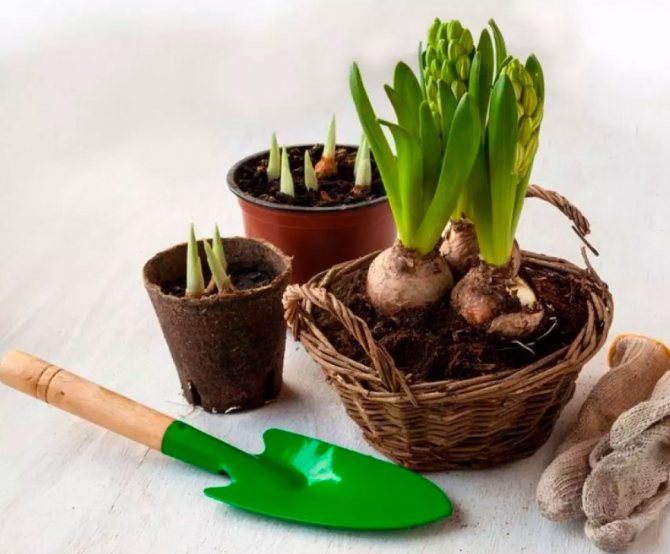

What time to plant
Hyacinth bulbs are planted in open soil in the last days of September or the first in October. If you plant them ahead of time, then they can start growing, and the coming winter cold will destroy them.If they are planted later than necessary, then they may not have time to take root well before frost.
The area where hyacinths will grow must be prepared in advance. Dig the soil to a depth of 0.3 to 0.4 m, while injecting 10 to 15 kilograms of rotten compost or three to four year old humus into the soil, as well as about 15 grams of magnesium sulfate, 70 grams of superphosphate and 30 grams of potassium sulfate from calculation for 1 square meter. Depending on what the soil consists of, peat or sand can be added to it, if necessary. If the soil on the site is sandy, then 1.5 times more potash and magnesium fertilizers should be added to it. It is recommended to feed hyacinths with nitrogen-containing fertilizers in the spring-summer period.
Planting in autumn


It was already mentioned above that hyacinth bulbs are planted in the garden in the autumn, or rather, in September-October. Experienced gardeners advise planting medium-sized bulbs, which are also called "flower beds", because they give flower stalks that are highly resistant to bad weather.
First, inspect the planting material and remove any diseased, soft or injured bulbs. Then, before planting in the soil, they are immersed in a solution of a fungicidal preparation for 30 minutes. The bulbs, reaching approximately 50 mm in diameter, are planted to a depth of 15 to 18 centimeters from the bottom, the row spacing should be about 20 centimeters, and the distance between the bulbs should be 15 centimeters. Smaller bulbs, as well as children, are planted at a shallower depth, while the distance between them must also be reduced.
Hyacinth grows best in open soil when planted in a sand jacket. To do this, a layer of pure river sand is poured onto the bottom of the groove or landing pit, the thickness of which should be about 30-50 mm. Press the bulb a little into this layer and sprinkle it on top with sand and only then with soil. Thanks to this method of planting, there will be no stagnation of water in the soil, as a result of which the risk of rot on the bulb will be significantly reduced. If the bulbs were planted in dry soil, then they must be watered.
Spring planting
Hyacinth bulbs are not planted in spring.
How to plant hyacinth at home
Preparing the onion
After the required rest period, we choose healthy, dense and large bulbs, more than 5 cm in diameter. To protect the plant from disease, the onions are treated with one of the antifungal solutions.
Boarding time
Most often, they want to get a blooming hyacinth for a certain holiday, for example, March 8 or Valentine's Day. On average, after planting, the plant blooms in 3-3.5 months. Therefore, in order to receive flowers on time, you need to calculate the planting time in advance.
Soil preparation
Before planting plants, you need to disinfect the soil. To do this, it can be ignited in the oven for 30 minutes or poured with a fungicide solution.
Landing
Hyacinth bulbs can be planted in an individual pot or in a flowerpot in several pieces, at a distance of 2-3 cm from each other, to obtain a lush bouquet.
- Drainage must be poured into the bottom of the pot.
- Fill the pot 2/3 full with soil.
- Plant the bulbs at half their height.
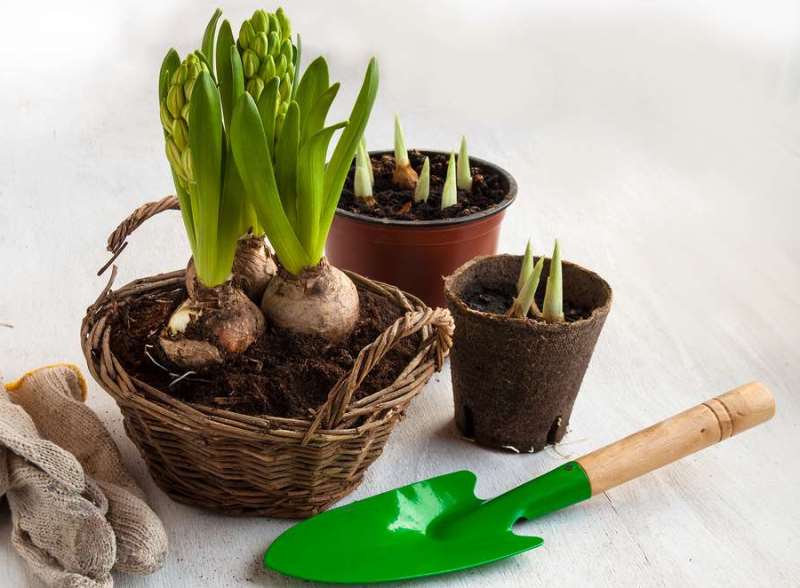

Rooting period
After planting, the plant must be watered without touching the bulbs and the pot must be removed to a dark, cool place at a temperature of about 5 degrees to root the plant.
The final stage of forcing
After the emergence of a sprout, about 5 cm high, the plant can be placed in a lighter and warmer room.
When buds begin to form, the plant is transferred to a bright, warm room with a temperature of 20-22 ° C.
Important. It is necessary to ensure a smooth change in temperature conditions.
Distillation in water
Some growers prefer to distill hyacinth without soil.
To do this, select a glass container with a neck of a smaller diameter than an onion. Water is poured into the container so that the distance between the water and the onion is about 5 cm. The container with the onion is placed in a dark, cool place. And with the appearance of the roots, they are transferred to a bright room.
Fertilizer must be added to the water once a month.
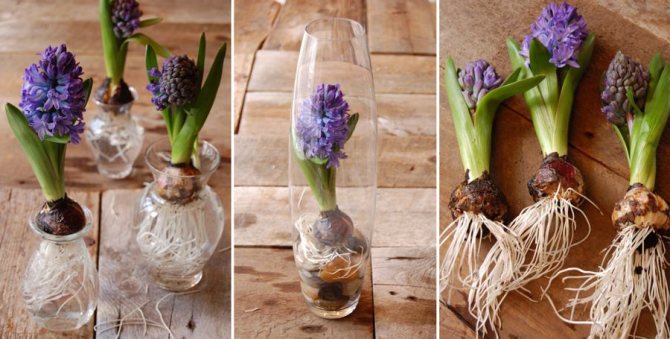

Varieties by color
Hyacinth has many colors. By color, the varieties are allocated to separate categories and have their own names and descriptions.
| Colors (varieties) | Description |
| Blue |
|
| Purple |
|
| White |
|
| Pink |
|
| Red and yellow |
|
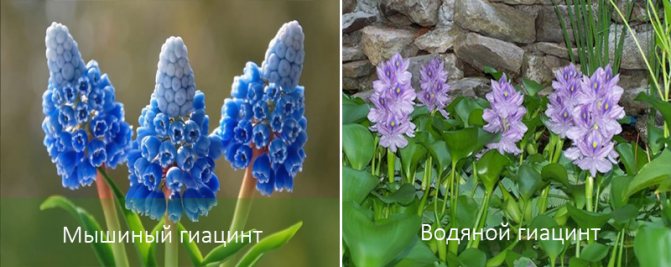

Hyacinth: origin, appearance and main properties
The genus Hyacinth belongs to the Asparagus family, whose representatives are common in the regions of Central Asia and the Eastern Mediterranean, namely in the Balkans, Syria and Turkey.
The name of the primrose in translation from Greek means "rain flower".
Hyacinth is a perennial herbaceous ephemeroid (plant with a very short growing season). The time of its growth, flowering and fruiting occurs in the spring, and during the period of hot summer, cool autumn and frosty winter, the development of the flower stops.
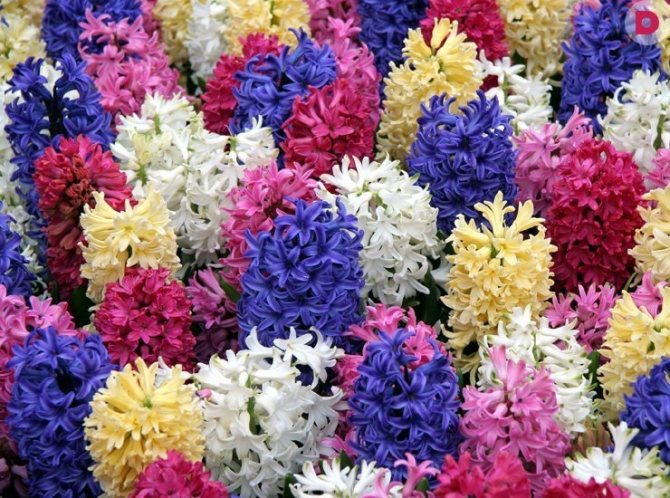

The range of hyacinth flowers is very wide
A large, dense hyacinth bulb has a rounded shape and is covered with thin membranous scales. The leaf blades are elongated.
Feature of the plant: during flowering, the size of the leaves is relatively short, and after the death of the peduncle, they grow up to 20 cm.
The bell-shaped flowers are decorated with thin and gracefully curved petals. Buds are numerous, on one racemose inflorescence from 12 to 35 or more of them can bloom. In the wild, the corolla of hyacinth is usually blue or white, and the range of varietal flowers is very wide.
Taxonomy
There are different points of view on the systematization of the genus. According to some scientists, there are about three dozen species, other researchers are sure of its monotypicity, i.e. it is one species that has many forms and varieties. Basically, only three species are distinguished among hyacinths, the most recognized and famous among which is the eastern one. All the most popular decorative varieties are created on the basis of it.
In an uncultured form, it can be found on the territory of Greece, Dalmatia, in the countries of Asia Minor. It is considered an exemplary species of the entire genus of hyacinths, and in all ambiguous situations it is used as a unique guardian of the species trait.
Currently, the plant has crossed the boundaries of its distribution area and is grown everywhere, not only as a decoration, but also as a medicinal one. The plant, whose height is about 30 cm and the thickness of the stem is 0.5 cm, is a perennial plant.
It is quite simple to care for it, which is why its cultivation in European countries has become fashionable since the 15th century. During these centuries, about three hundred excellent elite varieties have been created. Holland is especially famous for their breeding, exporting millions of copies.
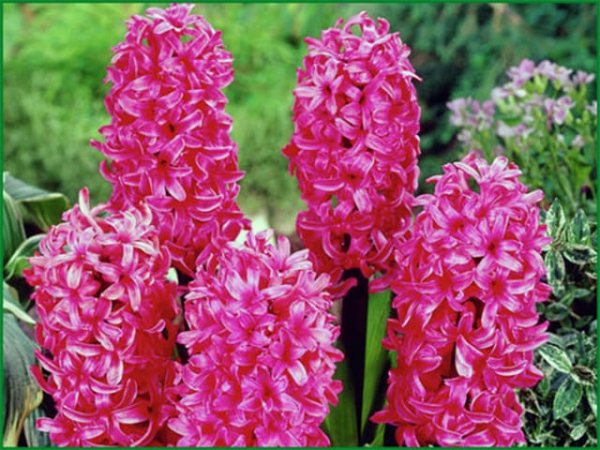

Litvinov's hyacinth is also a perennial herbaceous flower, usually grown as one year. In its original form, it can be found in the east of Iran and Turkmenistan, and it can be both tall and short.
The extraordinary beauty of the flower, colored in blue, lilac, purple and greenish shades and having slightly expanded leaves compared to the oriental look, is striking. Transcaspian is distinguished by rather high stems and two peduncles, usually light blue in color. The wild variety is found in the mountainous regions of the Kopetdag.
To grow at home, you need to choose a specific hybrid according to its botanical characteristics:
- by height;
- by the timing of flowering;
- by color.
The last factor is of great importance. White, pink, azure and purple shades are popular. The recognized leaders for breeding at home are considered the varieties "Aida", "Aqua", "Odyssey", "Jan Bose", "Lady Pink".
Cleaning and storage
Hyacinth bulbs left in the soil for the winter will bloom less next year. Therefore, experienced gardeners recommend digging them up. It is better to do this in the last days of June - early July. In addition, removing the bulbs makes it possible to carefully examine them and select healthy specimens, preventive treatment against insects and infection. The bulbs are removed from the ground, washed, dried in the shade and freed of any remaining roots and leaves.
It is important to ensure correct storage as during this period, an inflorescence is laid. The bulbs must be sorted out in size and placed in boxes with a maximum of two layers. It is not necessary to separate the small baby. Packaging in paper bags is acceptable. Subsequent storage is organized in 2 stages. First, the bulbs are kept for about 60 days at 25 - 26 °. The next stage is stored for 1 month at a temperature of 17 °. It is necessary to maintain a moderate humidity indoors, otherwise the bulbs will dry out.
Sometimes during storage, small children appear around the bottom of the bulbs. Since they are easily damaged, the bulbs with them must be planted very carefully, and the depth of burial should be halved and do not forget to cover such bulbs with a thicker layer.
Collecting bulbs and wintering culture
As soon as all the hyacinths have faded, you will need to continue feeding and watering. You cannot immediately dig up the bulbs, since the flower needs some more time to go into rest mode.
If the bulbs are not dug up for storage every year, there is a high risk that the next season will bloom less than the previous one. Only residents of the southern regions of the country can take such a step, where there are appropriate temperature conditions for normal rest and nutrition of the bulbs in the ground. For the middle lane, it is better to choose an alternative option and dig up all the bulbs in the last weeks of June or early July.
It is necessary to remove all the bulbs at once, remove the remnants of vegetation and roots from the soil and from the seed. Place the bulbs in a well-ventilated area. It is best to store the planting material in boxes in a dark place, where it will dry enough for the autumn sowing.
Hyacinths in landscape design, photo - examples of flower bed design
Hyacinth flowers are among the most popular garden plants. This is due to the richness of colors and ease of growing. Planted in clusters of the same color, these beautiful flowers create spectacular flower arrangements in the flower beds. They also look good in pots and wicker baskets.
Photo. Flowerbeds and flower beds with hyacinths
When planning a large flower bed, it is worth planting hyacinths in groups - several, ten or so bulbs of the same variety. Flowers create spectacular, colorful islands.
Choosing simultaneously flowering varieties, you can achieve the effect of a patterned carpet, scarf.


Hyacinth is a wonderful decoration for any garden, summer cottage, small flower bed.The plant is easy to grow, planting bulbs does not involve special activities, shoots are easy to care for, regular watering is needed, especially during periods of drought. These extremely beautiful plants are probably the most beloved in the spring, they produce an extremely magnificent inflorescence, strongly colored and aromatic. Not surprisingly, many people choose to grow this adorable bulbous plant in their garden or pots at home.
Features of hyacinth
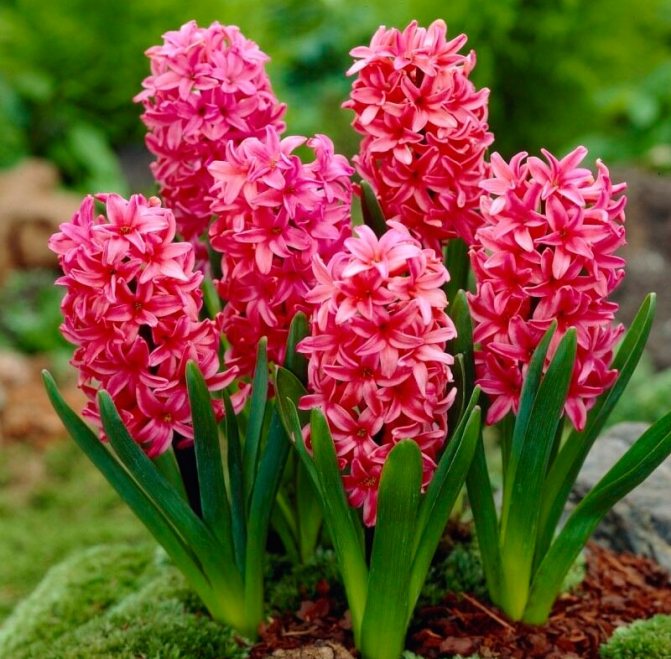

Hyacinth is one of the earliest spring flowers. This plant is native to North Africa, the Middle East and the Mediterranean. However, Holland has done a lot to popularize hyacinth, which is why many people call it the world "hyacinth center". The largest number of varieties and varieties of hyacinth appeared in the Netherlands. And from the city of Haarlem, which is located in Holland, a huge number of bulbs of this flower are sent around the world every year.
In hyacinths, a dense bulb consists of lower juicy leaf plates. The height of the flowering stem is about 0.3 meters, it is a continuation of the bottom. In a faded bush, the stem dries up along with narrow leaf plates directed upwards, which sit at the very bottom of the stem. However, in the corner of the upper leaf plate on the stem inside the bulb, a bud is formed, which eventually becomes a new bulb, it will be she who will bloom next year. Bulbs can also form in the corners of other leaf plates, but they are weaker. These bulbs are babies, if necessary, they can be separated and new bushes can be grown from them. Flowers are part of the apical brushes, which have a conical or cylindrical shape. In a flower, the perianth has the shape of a bell-shaped funnel, its blades are bent, and the color is saturated. Inflorescences can be colored in different shades, for example: red, purple, yellowish, white, pink, blue, etc. Flowers can be double or simple. In such a plant, the fruit is three-nested, while in each of the nests there is a pair of seeds covered with a delicate peel.
Transplanting Hyacinths
Let's take a look at the question of when is the best time to transplant hyacinth. During flowering, the plant spends a lot of energy and does not tolerate manipulations with the root system, therefore, immediately after buying a blooming hyacinth, it should not be disturbed. But, as soon as the plant fades, the arrow of the peduncle can be cut off, and the bulb can be transplanted into a new pot or planted in the ground.
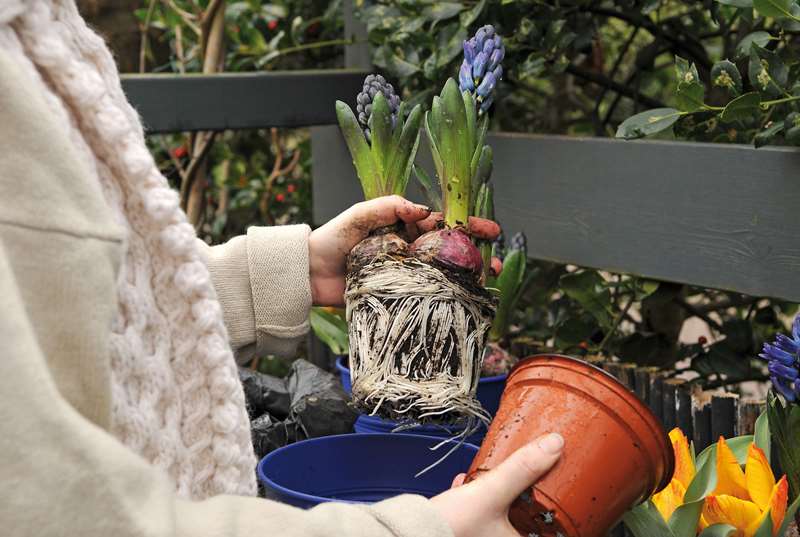

There are times when a plant transplant during flowering is simply necessary. Then, acting very carefully and following simple requirements, it is quite possible to transplant a flowering bulb practically without disturbing it.
The procedure will require:
- low pot with a diameter of 10 cm;
- drainage: expanded clay, fine gravel or brick chips;
- ready-made universal primer for indoor flowers;
- fine river sand;
- settled water at room temperature.
Drainage is laid on the bottom of the pot with a layer of up to 1/3 of the capacity, a layer of sand is poured on top. Now you need to carefully remove the bulb from the pot, being careful not to damage the roots, and place it in the center of the new container. While holding the bulb with one hand, gently pour the soil into the pot around it. About half of the bulb should be above the soil surface. The land around the plant is watered abundantly. Until the plant takes root, it is not exposed to the southern windows, keeping in the shade.
It is best to wait until the hyacinth has faded and the aboveground part of its bulb is dry. Then it can be removed from the ground without consequences and planted in a new place.
The appearance of a peduncle and further care of a flowering plant
With proper care, the hyacinth quickly develops a peduncle. As soon as the leaves begin to break out of the bulb, you can see the developing buds.
Now for the good development of the flower, it is necessary to maintain a temperature of about 20 ° C, protect it from temperature drops and drafts. Twice a month, fertilize the plant with fertilizers to stimulate flowering and maintain the soil moisture necessary for the plant.
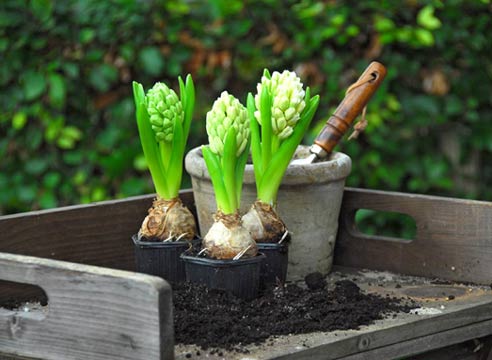

Breeding in a garden or cottage
The plot must be equipped in advance - 2 months before planting, so that the roots do not damage the natural sediment of the soil. It is advisable to thoroughly cultivate the soil. When to plant bulbs in the fall depends on the region.
In the central regions of the country, planting is carried out in September - October. Agricultural technology suggests that planting too early is fraught with premature growth and death in the cold, and if the planting is too late, the plants will be late with rooting before freezing.
On the site, it is recommended to plant not large specimens suitable for forcing, but of a moderate size that are resistant to weather conditions. Planting can be extended until the beginning of November, if the site is covered with foliage or film for protection in advance and covered again after planting.
The distance between the holes is about 20 cm, the depth is 18 cm for large seeds. Children are planted more often and smaller. The technique is the same. Rooting plants improves watering. A large number of hyacinths are planted in 15 cm high beds to protect them from melted snow. It is convenient to place a film shelter on them, and in the cold season it is advisable to use mulching with sawdust, peat, humus, dry foliage.
There is a way to grow without using soil - in water. The method works in reality, an indispensable condition is the use of mineral fertilizers dissolved in it, and the bulb should only be in contact with the surface. Initially, it is placed in a dark room, and after the formation of roots, it is transferred to the light.
How to preserve a bulb after flowering
Further care of the bulb is simple, you need to know just a few rules:
- After the plant has bloomed, you need to cut off the peduncle, leaving the leaves.
- If the plant is in a small pot, then it should be transferred into a larger container, without deepening the neck of the bulb. So the plant will continue to develop and build up children.
- It is best to keep the plant in a cool, light place.
- Now water the hyacinth should be less abundant and after the soil dries out.
- By about mid-May, the leaves will completely dry out and watering should be stopped.
- Next, you need to cut off the dried leaves, pull out the bulb and carefully clean it from the ground, remove the dead scales.
- Dry the bulbs for 3 days.
- Store bulbs in a dark, warm, well-ventilated area, in a cardboard box, paper bag or sawdust for about 2 months.
- For a month before planting, the bulbs must be kept in a cool, humid room with a temperature not exceeding +5 ° C.
The hyacinth flowering phase lasts 2-3 weeks. The flowering period must necessarily be replaced by a dormant period, it is important to ensure a smooth transition between them. This will allow the bulb to rest and gain strength to continue to delight you with bright colors.

